| |
FIG PUBLICATION NO. 44
Improving Slum Conditions through Innovative
Financing
FIG/UN-HABITAT Seminar
Stockholm, Sweden, 16–17 June 2008
|

© Klas Björkhagen |

© Klas Björkhagen |
Contents
Foreword
List of Acronyms
Seminar Information and Proceedings
Key Web Sites
Acknowledgements
Introduction
About the Seminar Organisers
DAY 1– LAND USE MANAGEMENT AND PROPERTY
RIGHTS
Opening Ceremony
Mr. Svante Astermo, Chair, Local Organising Committee
Professor Stig Enemark, President of FIG
Mr. Andreas Carlgren, Minister for the Environment,
Sweden
Keynote Address
Excerpts from Keynote Address
Mrs. Anna Tibaijuka, Under Secretary General and Executive Director, UN-HABITAT
Sustainable Urban Development and the
Millennium Development Goals
Environment and Climate: The Role and Importance of
Property and Land Administration Institutions in Society
– Mr. Andreas Carlgren, Minister for the Environment, Sweden
Legal Empowerment in a Globalizing World
– Mr. Ashraf Ghani, Institute for State Effectiveness and Chair of the Working
Group on Property Rights of Legal Empowerment
Partnership between FIG and the UN Agencies in Support
of the Millennium Development Goals
– Mr. Stig Enemark, President, FIG
Land Administration and Property Rights – How
to Achieve the Basic and Fundamental Structure?
Land Policies across Geography and Time: An
Overview of Land Policy Issues Based on Lincoln Institute’s Experience in Latin
America
– Lincoln Institute of Land Policy
Analytic Conclusions Regarding Countries in Transition:
Spatial Information Management toward Legalizing Informal Urban Development
– Ms. Chryssy Potsiou, Chair of FIG Commission 3, UN-ECE/Working Party on
Land Administration
Development of Land Administration and Links to the
Financial Markets
– Ms. Dorothy Agote, Permanent Secretary, Ministry of Lands, Kenya
Social and Economic Impacts of Land Titling Programmes in
Urban and Peri-Urban Areas: International Experience and Case Studies of Senegal
and South Africa
– Geoffrey Payne, Geoffrey Payne and Associates, U.K.
Women’s Access to Land and Finance
– Ms. Ayanthi Gurushinge, Country Coordinator, Slum Upgrading Facility, Sri
Lanka
Dialogues: Land Use Management and
Property Rights – Outlining the Roadmap
Group 1 – Southern and Eastern Africa
Group 2 – Asia and the Pacific
Group 3 – West Africa
Group 4 – Central and Eastern Europe
DAY 2 – JUST AND SUSTAINABLE SHELTER FINANCE
SYSTEMS
Land Administration and Finance Systems
Expanding the Outreach of Housing Finance for the
Urban Poor – A Matter of Cooperation Combined with Sufficient and Appropriate
Due Diligence
– Mr. Michael Mutter, Senior Advisor, Slum Upgrading Facility, UN-HABITAT
Channelling the Global Financial Flows for Adequate
and Affordable Housing
– Ms. Renu Karnard, President, International Union for Housing Finance
Land Finance through Land Governance – Expanding the
Discussion of Land Policy during Food Crisis, Climate Change and Rapid
Urbanization
– Mr. Malcolm Childress, Senior Land Administration Specialist, The World Bank
Housing Finance for All – Swedish Engagement in Land
Administration and Housing Finance
– Mr. Dan Ericsson, State Secretary, Ministry of Finance, Sweden
Putting Innovative Systems for Functioning
Finance into Practice
Innovative Structures for Financing Slum Housing
and Infrastructure
– Mr. P. R. Anil Kumar, Head (Microfinance), Emerging Markets, Barclays Bank
PLC
Local Finance Facilities: What They Are, Why They Are
Important, and How They Work
– Ms. Ruth McLeod, Emerging Markets Group Dialogues
Dialogues
Dialogue 1: Land management practices and tools and
links to efficient finance
Dialogue 2: Revisiting planning: Cutting the costs,
involving the rights of the poor and enabling adequate finance
Dialogue 3: Linking the financial sources
Dialogue 4: Expanding the outreach of housing finance
for the urban poor
Special Component on Land and
Gender
Wrap Up and the Way Forward
Orders for printed copies
This publication is a summary report of the seminar “Improving Slum
Conditions through Innovative Financing”, which was jointly organized by
the International Federation of Surveyors, FIG and the United Nations Human
Settlements Programme (UN-HABITAT) and took place in Stockholm, Sweden on
16–17 June 2008. This two-day seminar, which was dedicated to adequate and
affordable housing for all, was an integrated part of the FIG Working Week.
The seminar focused on the essential elements of a just and sustainable
provision of adequate shelter, from the twin perspectives of land and finance.
It brought together leading actors from the public, private and non-governmental
sectors working on land and housing finance issues. Within this framework, the
seminar focused on the main issues of access to land, security of tenure and
access to finance. Without security of tenure, the poor are at daily risk of
eviction and, in the longer term, are reluctant to invest in long-term shelter
improvements. Without access to affordable finance, poor people are caught in a
vicious cycle in which affordable housing is inadequate, but adequate housing is
unaffordable.
Surveyors and land professionals play a key role in linking functioning
markets for housing and finance. Therefore FIG is keen to co-operate with
UN-HABITAT in this area as part of the long-term co-operation between the two
organizations. The FIG/UN-HABITAT seminar brought together some of the leading
innovators in the areas of land and finance. The seminar was structured as a
practitioners’ dialogue – communication across professional and institutional
perspectives. A total of eight Dialogues were held. Amongst the core issues
discussed were various forms of individual and collective rights, women’s equal
access to land and finance, spatial planning, security of tenure and innovative
financial instruments. Proceedings of the seminar are available at
www.fig.net/pub/fig2008 and a
dedicated web site for the project at
www.justnsustshelter.org.
This report provides a summary of the presentations that were given to
catalyse the Dialogues, the key issues that emerged in the Dialogues themselves,
and the conclusions reached and directions for the way forward that were put
forth at the seminar’s closing.
The result of the seminar aims to provide a valuable contribution to the IV
World Urban Forum, to be held in Nanjing, China in November 2008. The
publication is a joint effort of FIG and UN-HABITAT and is published in the FIG
Report series.
Stig Enemark
FIG President
|
Anna K. Tibaijuka
Under Secretary General
Executive Director UN-HABITAT |
List of Acronyms
| BRICS |
Brazil, India and China |
| FAO |
The Food and Agriculture Organization of the United Nations |
| FIG |
International Federation of Surveyors |
| GLTN |
Global Land Tool Network |
| LFSUS |
Lanka Financial Services for Underserved Settlements |
| MDGs |
Millennium Development Goals |
| MFI |
Microfinance institution |
| NGO |
Non-governmental organization |
| SPARC |
Society for the Promotion of Area Resource Centres |
| STDM |
Social Tenure Domain Model |
| SUF |
Slum Upgrading Facility (within UN-HABITAT) |
| UN-HABITAT |
United Nations Human Settlements Programme |
Seminar Information and Proceedings
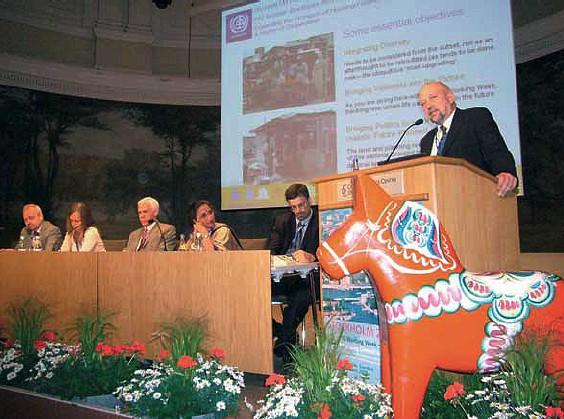
Mr. Michael Mutter, UN-HABITAT making his keynote presentation at the second
plenary session of the FIG/UN-HABITAT seminar. © FIG
The seminar “Improving Slum Conditions through Innovative Financing”
was organised jointly by FIG and UN-HABITAT. It was made possible by the
generous support from Swedish authorities: Lantmäteriet (the National Mapping,
Cadastre and Land Registration Authority of Sweden), the Swedish Government (the
Ministry of the Environment and the Ministry of Foreign Affairs), Swedesurvey
and Statens Bostadskreditnämnd BKN (National Housing Credit Guarantee Board).
We would like to express our thanks to all speakers and participants who
attended the dialogues and contributed to this report. Our special thanks go to
Ms. Ann Jennervik, who was in charge of organising the seminar together
with Mr. Bengt Kjellson and Mr. Lars Magnusson. We also thank Mr.
Brett Shapiro who has been the editor of this report together with Mr.
Szilard Fricska from UN-HABITAT and Professor Stig Enemark from FIG.
As an integrated part of the International Federation of Surveyor’s (FIG)
Working Week, a two-day seminar was dedicated to adequate and affordable
housing for all. The seminar, “Improving Slum Conditions through
Innovative Financing” was jointly organized by FIG and UN-HABITAT and
took place in Stockholm, Sweden on 16–17 June 2008.
The meeting brought together leading actors from the public, private and
non-governmental sectors working on land and housing finance issues. The seminar
focused on the essential elements of a just and sustainable provision of
adequate shelter, from the twin perspectives of land and finance. The role of
land and finance provision can be conceptualized as the challenge of linking the
various components of “the Land Administration Chain”: mapping; planning;
property and land rights; cadastral services; valuation; financial services (see
figure below).
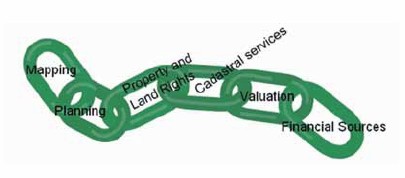
Linking the Land Administration Chain.
Within this framework, the seminar focused on the main issues of access to land,
security of tenure and access to finance. Without security of tenure, the poor
are at daily risk of eviction and, in the longer term, are reluctant to invest
in long-term shelter improvements. Without access to affordable finance, poor
people are caught in a vicious cycle in which affordable housing is inadequate,
but adequate housing is unaffordable.
The theoretical solution to this dilemma is a well-functioning land and housing
market; however, experts around the world recognize that these same markets are
often dysfunctional, and arguably represent the most consistent bottleneck
undermining long-term city development. Market access is built on transparency,
low transaction costs and good access to reliable property information as well
as property financing. Facilitating efficient land markets and effective
land-use management is therefore critical to sustainable urbanization.
Surveyors play a key role in linking functioning markets for housing and
finance. Support to this aim is being provided, but despite 30 years of efforts,
political commitments and reiterated priority to the issue, little has been
achieved. Building up the key institutions that can manage the public systems
providing key public goods is at best a slow process. The vested interests of a
wide variety of stakeholders conspire to maintain the status quo.
There are signs of progress, however, and the FIG/UN-HABITAT seminar brought
together some of the leading innovators in the areas of land and finance. The
seminar was structured as a practitioners’ dialogue – communication across
professional and institutional perspectives. A total of eight Dialogues were
held. Each set of Dialogues was prepared through sharing inputs at the
interactive website
www.justnsustshelter.org and through the introductory presentations at the
Plenary and Presentation sessions. Amongst the core issues discussed were
various forms of individual and collective rights, women’s equal access to land
and finance, spatial planning, security of tenure and innovative financial
instruments.
The seminar aims to provide a valuable contribution to the next World Urban
Forum, to be held in Nanjing, China in November 2008.
This report provides a summary of the presentations that were given to catalyze
the Dialogues, the key issues that emerged in the Dialogues themselves, and the
conclusions reached and directions for the way forward that were put forth at
the seminar’s closing.
About the Seminar Organisers
International Federation of Surveyors (FIG)
The International Federation of Surveyors, FIG, is an international,
non-government organisation (NGO) whose purpose is to support international
collaboration for the progress of surveying in all fields and applications. FIG
aims to mobilize the next generation of land professionals to continue to
develop innovative solutions to address global inequality in access to land and
security of tenure. FIG’s annual “Working Week” took place in Stockholm, Sweden
and was the biggest Working Week ever held, with 950 participants from 90
nations attending the event and exhibition. In addition to the plenary sessions,
there were over 70 technical sessions, with almost 350 presentations and
technical tours. A strong attraction was the two-day joint FIG/UN-HABITAT
seminar on “Improving Slum Conditions through Innovative Financing,” which was
an integral part of the entire Working Week. FIG is strongly committed to the
Millennium Development Goals (MDGs) and to supporting the work of the Global
Land Tool Network (GLTN), whose aim is to contribute to poverty alleviation and
the MDGs through land reform, improved land management and security of tenure.
United Nations Human Settlements Programme (UN-HABITAT)
UN-HABITAT is the United Nations agency for human settlements. It is mandated by
the UN General Assembly to promote socially and environmentally sustainable
towns and cities with the goal of providing adequate shelter for all. Within
this mandate, the Slum Upgrading Facility (SUF) provides global assistance for
the design and implementation of locally produced ‘bankable housing projects’ so
that groups of low income residents and their local authorities can attract
domestic commercial finance as a significant part of the funding of their
sustainable neighbourhood slum upgrading and low-income housing projects on a
community-led repayment scheme basis. With respect to land issues, UN-HABITAT
also hosts the Secretariat for the GLTN. GLTN partners have identified 18 key
land tools to deal with poverty and land issues at the country level across all
regions. One of GLTN’s work areas is the nexus between intermediate forms of
tenure and access to housing finance for the poor.
Day 1 – Land Use Management and Property
Rights
The theme during the first day was Land Use Management and Property
Rights. Land Administration is a term used to describe all the processes
connected to a functioning property system. This includes land management,
planning and monitoring land use, the creation and keeping of cadastre, the
establishment, recording and protection of different kinds of property rights
and the securing of mortgage rights in order to make capital available to
property owners or leaseholders. Land administration systems look different in
different countries and regions and are evolving in different ways. This is due
to the political circumstances, cultural and legal traditions and economic
conditions that exist in each particular setting.
The Opening Ceremony featured the symbolic tying of a ribbon, representing
the continuity between the current and future generation of land professionals.
Speakers at the opening ceremony included the following:
Mr. Svante Astermo, Chair, Local Organising
Committee
Mr. Astermo welcomed all of the participants, mentioning that the 950
participants from 90 countries represented an all-time high for the FIG Working
Week. He was particularly pleased to see the presence of so many students, given
that they are the key to “integrating generations” – creating the bridge between
countries, cultures and ages.
Mr. Enemark reiterated FIG’s support of the concept of integrating
generations, acknowledging the many students and young surveyors present who
represent the future. He also mentioned a full-page article that appeared in one
of the major Swedish daily newspapers in which surveyors were called upon to
address the problems of the slums, and stated that FIG is becoming a major
partner in achieving sustainable development. At the same time, there is a need
to better understand the very key role that the profession plays in sustainable
development at the national and local levels. The work of surveyors forms a kind
of backbone to society and is a key component to the achievement of the MDGs.
The global development agenda is about eradication of poverty in all its forms.
Property is not only an economic asset, he stressed, but secure property rights
also provide a sense of identity and belonging that goes far beyond economics,
and underpins democracy and human freedom. Land surveys have a key role to play
in developing pro-poor systems. Professor Enemark then introduced the concept of
land governance, which is the governmental side of managing physical space for
power, wealth and human well-being. The key challenges of the new millennium are
related to climate change, urban growth, environmental degradation, natural
disasters and food shortages. All of these challenges relate to the governance
and management of land. Thus, land governance and management are going to be
important subjects for surveyors, issues which will require new models to
predict and address changes, and land administration systems that can manage the
core functions of land value, land use and land development.
Mr. Andreas Carlgren, Minister for the
Environment, Sweden
Mr. Carlgren emphasized that land professionals “have such an important key
role to play, to combat environmental threats, to combat poverty and slums and
to support the development of this globe and its cities.” He then tied two
ribbons together as a symbol of integrating generations.
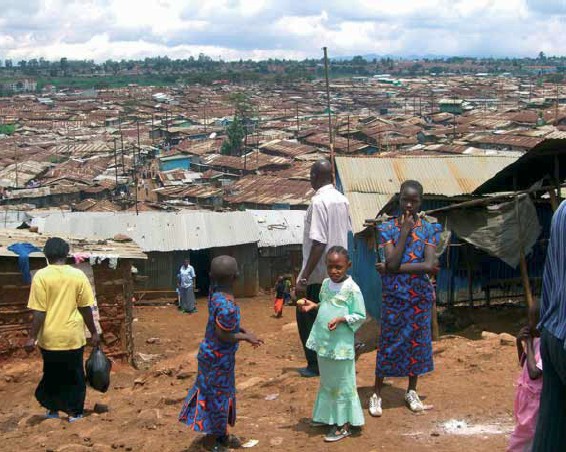
Kibera, Nairobi. © Stig Enemark
Excerpts from Keynote Address
– Mrs. Anna Tibaijuka, Under Secretary General and Executive Director,
UN-HABITAT
|
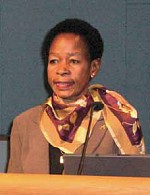
© FIG |
“FIG and UN-HABITAT have a shared history that goes back over two
decades. I am pleased to see that this meeting is taking place when the
Swedish Association of Chartered Surveyors is celebrating its 100th
anniversary. I am also pleased to be in Stockholm because UN-HABITAT has
a history here dating back to 1972 when the concept of sustainable
development was born… The theme of the seminar, Integrating
Generations, highlights the need to attract new generation of young
surveyors and new capacities to address to new priorities… |
I would like to present two critical issues that we see shaping the
global debate on development. They are sustainable urbanization and climate
change, and they are interlinked. I would also like to reflect on the role
that surveyors and land specialists can play…
We are becoming more urban, and this will not change. People move because
they expect to have a better life. It is the expectation that pushes them,
and the prospect keeps them there. The challenge is to guide the
urbanization process. Ninety-five percent is taking place in cities least
equipped to deal with it, in African and in Asia. We are witnessing
urbanization of poverty. Today there are an estimated 1 billion slum
dwellers, and this could double by 2030. A report published by UN-HABITAT in
2006–2007 confirms that slum dwellers are more likely to have less education
and fewer employment opportunities, and suffer malnutrition more than any
other segment of the population. Living in cities does not translate into a
better life. How is the international community responding? UN-HABITAT
conducted an exercise in 2005 to determine the resources required. Our
estimate showed that US$ 300 billion would be required over a 15-year period
if we wanted to put the slum challenge behind us. While these exercises are
nothing new, the uniqueness of this exercise was in its recognition that the
urban poor, when properly enabled and empowered, are able to mobilize 85
percent of the resources required…
…We know that an aid-based approach is not enough. We need to think outside
the box, we need to think in terms of changing the rules of the game that
prevent the majority of the urban population in developing countries from
growing out of poverty. …Let me outline some of the challenges of slum dwellers
from the land perspective. Only 20 percent of land parcels in the world are
registered, while most poor people live under customary or informal tenure
systems. Only 2 percent of land is registered in women’s name, and women are
frequently at risk of losing their land rights upon the death of their spouses.
Land titling rarely meets the needs of thepoor due to the costs of adjudication,
high technical standards, expensive registration and transfer fees, and literacy
requirements. Planning and zoning standards are similarly inappropriate and
unaffordable. In short, the very legal system that should protect and empower
the poor more often fails them. This is one of the most important findings of
the Commission for the Legal Empowerment of the Poor and I would encourage you
all to read the Commission’s report [see
http://www.undp.org/legalempowerment/]…
As in the world of land, slum dwellers are often systematically excluded from
the so-called ‘formal’ system of housing finance, in particular, mortgage
finance…
Banks are constrained by the very systems of credit risk analysis they use:
financial, legal and technical. Their financial analysis is biased towards
people with bank accounts, formal sector jobs and a proven credit history. In
their legal analysis, financial institutions look for legally recognized
evidence of ownership and the possibility of repossessing the asset through the
courts in case of default. And, from their technical analysis, they will look
for proof of a building permit and conformance to zoning regulations. From all
three risk analysis perspectives, the poor fail the test of the formal credit
markets…
Micro-finance institutions do better for the poor. They will provide small
loans. They will not demand land as collateral. However, the loans they give are
not housing loans. They are housing loans disguised as consumption or as
business loans. This may be a stop-gap measure, but it struggles to meet the
full demand for housing loans…
There are signs of hope in the area of housing finance. In particular, group
savings and cooperatives represent promising solutions. Savings schemes are
established amongst groups of slums dwellers – mainly by women – who wish to
improve their living conditions through a specific project. They establish
themselves as a legal entity, which enables them to consider taking a loan. The
size of the loan will be determined by their ability to repay. This becomes the
basis for designing a bankable project. Financial institutions become interested
because the loan size is large and the transaction costs are low. From this
model, and others that are out there, it is clear that the poor can provide
their own housing solutions…
But housing finance is only one piece in a much larger challenge of
sustainable urbanization. Reforms are required on a number of fronts, including:
land market regulation, shifting to more strategic urban planning, adopting
pro-poor building regulations, improving land-based tax collection to create
municipal revenue, making budgeting more participatory and accountable, and
creating the foundations for sustainable investments in infrastructure and
service delivery…
What is the role of surveyors and land professionals in the creation of a
sustainable urbanization paradigm? I would like to highlight six critical areas:
- Better information for better decision making and planning
- Disaster risk reduction tools
- New land administration tools appropriate for developing countries
- Strengthened capacity in land valuation and land value capture
- A new generation of surveying and volunteerism, to strengthen the
capacity of
land professionals in the South
- Good land governance; that is, the process of managing competing
interests in
land in a way that promotes sustainable urbanization.
In this regard, I would like to highlight the important role being played by
the GLTN, and its partners in promoting innovative solutions to realize secure
land rights for all. FIG and UN-HABITAT have worked closely together under the
GLTN umbrella to make this seminar a reality…
I hope this meeting will help set a new agenda for sustainable development
and climate change.
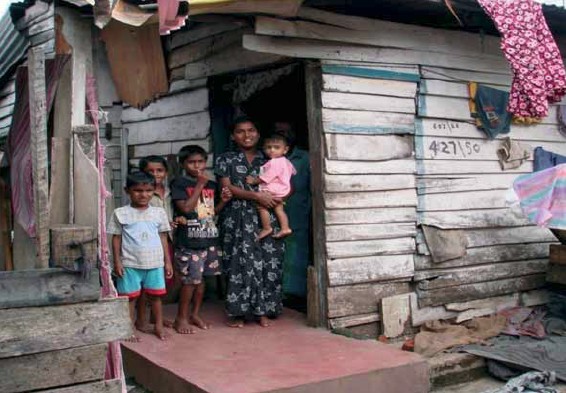
Colombo, Sri Lanka. © Ayanthi Gurushinge
Sustainable Urban Development and
the Millennium Development Goals
Environment and Climate: The Role and Importance
of Property and Land Administration Institutions in Society
– Mr. Andreas Carlgren, Minister for the Environment, Sweden
|

© FIG |
Mr. Carlgren stated that one half of the earth’s systems are in the
process of being destroyed and that there are serious risks and
consequences for combating poverty and access to clean water, the
effects of which can be seen in droughts, floods and outbreaks of
environmentally related diseases. He recounted a meeting of
environmental ministers from 30 countries from around the world that
took place in the north of Sweden. The participants were standing close
to the largest river in the north of Sweden and were drinking from its
water and talking about the destruction of rain forests in Brazil and
the risk of flooding of hundreds of islands. As they stood there, they
experienced the connections and the distances shrinking. The
participants felt that the world is closely connected, both in terms of
threats and hopes. |
Mr. Carlgren urged everyone to commit themselves to combat climate change and
to strive towards a global agreement next year in Copenhagen in 2009, the year
in which Sweden will hold the presidency of the European Union. He affirmed that
Sweden is prepared to reach a global agreement and knows that the world will
undergo an enormous shift towards sustainable development – simply because it
must.
Mr. Carlgren then spoke about the scale of urbanization taking place in
developing countries, with 18 million people moving from the country to cities
each year in China alone. Each day the global urban population grows by 180,000.
A major part of all construction will take place in the large developing
countries. How these cities are built will have an enormous impact on the
environment and quality of life, but also on the long-term possibilities for
tacking climate change. Eighty percent of greenhouse gas emissions originate
from urban areas. But it is possible to change urban development and have
flourishing economies at the same time. If planned and managed correctly, cities
hold possible solutions for many of these problems. For example through
infrastructure, energy and transport solutions, sustainable urban development
cannot only boost the economy and quality of life, but also be part of a global
zero-carbon-producing planet.
Mr. Carlgren described how in Sweden 40 percent of energy supplied is from
renewable sources, and will increase to almost 50 percent soon. Sweden has also
reduced its carbon emissions in absolute terms by 9 percent since 1990, and
without creating problems for the economy. In fact, the economy has increase by
44 percent. Therefore, emissions and economic growth can be delinked. He
mentioned different measures and technologies that have been important,
including economic instruments such as carbon tax, district heating and cooling
systems, and expansion of wind power.
He emphasized that this conference is extremely important in order to
exchange experiences and new solutions. The availability and dissemination of
knowledge and information are vital for combating climate change and adapting
society. Satellite imagery data bases and other reliable cartographical data are
essential, as well as action programmes to analyse the risks of natural
disasters. Guaranteed rights of ownership are also essential for sustainable
development.
Legal Empowerment in a Globalizing World
– Mr. Ashraf Ghani, Institute for State Effectiveness and Chair of the
Working Group on Property Rights of Legal Empowerment
|
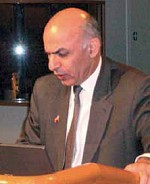
© FIG |
Mr. Ghani began by stating that one third of the world’s poor – one
billion people – live without any legal protection of their assets, and
that poverty is a result of the failure of public policies and markets.
In fact, in many countries the laws, institutions and policies are a
barrier to prosperity. He highlighted the recently launched report of
the Commission for the Legal Empowerment of the Poor, “Making the Law
Work for Everyone.” Legal empowerment, he stated, is the process through
which the poor become protected and are enabled to use the law to
advance their rights and interests. He then described the Commission’s
four-pillar approach to empowering the poor: access to justice and the
rule of law; property rights; labour rights; and business rights. The
four key building blocks are interdependent, and when one or more of
them is missing, dysfunctionality results. He then highlighted four
types of dysfunctionalities: misalignment of social practices and legal
provision; misuse of rules governing property; lack of access to
information and justice; and misuse of eminent domain. |
To arrive at solutions, he emphasized that it was not enough to rely on
aid-based approaches.Rather, it is critical to look at globalization and
inclusion. Globalization is of human making but not of human design. Most of the
world feels dislocated by the process of globalization. There are five
challenges for harnessing globalization:
- Build functioning state and markets in the 40–60 states that are the
weak links of the international system.
- Tailor strategies and partnerships to the BRICS (countries like Brazil,
India and China) and other emerging countries.
- Bring corporations into a global development compact.
- Rethink relations between regional and international security as well as
political organizations.
- Invest in national, regional and international leadership and
management.
Governance needs to re-framed, he stated, as network governance. The task is
to bring states, markets, corporations, civil society and international
organizations together. In the next 25 years, US$ 42–44 trillion will be
invested in global infrastructure. These investments make global economic
integration possible, but could also have severe negative consequences. Getting
the design right is critical. Creating liveable cities is critical for the
agenda of inclusive globalization. But creativity and imagination need
collaboration among many actors. Information, knowledge and wisdom need to be
brought together in harmony.
Mr. Ghani concluded by quoting a Native American saying: “We do not
inherit the earth from our ancestors, we borrow it from our children.”
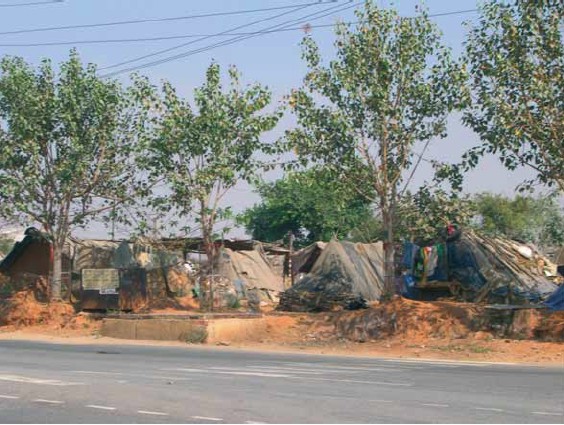
Hyderabad, India. © Stig Enemark
Partnership between FIG and the UN Agencies in
Support of the Millennium Development Goals
– Mr. Stig Enemark, President, FIG
|
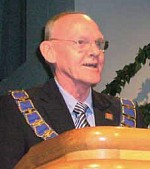
© FIG |
Mr. Enemark spoke first about the land management paradigm, which
includes all activities associated with the management of land and
natural resources that are required to fulfil political objectives and
achieve sustainable development. These include the land policy
framework, land administration functions, land information
infrastructures and the country context, all of which feed into the land
administration system and its impact on sustainable development. Land
administration systems are the basis for conceptualizing rights,
responsibilities and restrictions – the “three Rs” – related to
property. |
A good property system is one in which people can participate in the land
market, make transactions and have access to registration. The infrastructure
supporting transactions must be simple, quick, affordable and free of
corruption. Moreover, the system must provide safety for housing and business,
as well as for capital formation. Land governance and management is a core area
for surveyors and will require:
- High level geodesy models to predict change
- Modern surveying and mapping tools
- Spatial data infrastructures to support decision making on the
environment
- Secure tenure systems
- Sustainable systems for land valuation, land use management and land
development
- Systems for transparency and good governance.
Mr. Enemark went on to speak about partnership, which is the eighth MDG and
can serve as the link that drives development. He emphasized FIG’s close
collaboration with UN-HABITAT, the Food and Agriculture Organization of the
United Nations (FAO), GTLN and the World Bank.
He concluded his presentation by emphasizing the role of FIG in terms of
professional, institutional and global development.
Land Administration and Property Rights –
How to Achieve the Basic and Fundamental Structure?
The afternoon started with introductory presentations on land administration
and property rights all over the world. The presentations covered lessons
learned from various regions: Latin America, European countries in transition to
an open and common market, and Sub-Saharan Africa. Special emphasis was put on
the importance of women’s equal access to land and finance.

Bukit Duri, Jakarta, Indonesia. © Suzi Mutter
Land Policies across Geography and Time: An
Overview of Land Policy Issues Based on Lincoln Institute’s Experience in Latin
America
– Lincoln Institute of Land Policy
The presentation was given by Ann Jennervik, Senior Expert Sustainable
Development, ee&sd, and was based on the first chapter of the Lincoln Institute
book entitled Urban Perspectives, an overview of critical land policy issues
based on the Institute’s experiences in Latin America. Ms. Jennervik summarized
five major points that came out of the study:
- Constraints on policy implementation. Most countries in Latin
America share poor performance when it comes to recovery of publicly
generated land value increments, the delivery of urban infrastructure and
services, the provision of housing alternatives for the urban poor, and
appropriate land taxation. In addition, there is a strong legacy of powerful
landowning interests that influence land policies to their own benefit.
- Unavailable or untapped resources. Urban land is still viewed as
an asset rather than as a taxable base to generate needed resources for the
broader community. Management of existing resources is often characterized
by a lack of operational capacity or unscrupulous behavior on the part of
authorities. Despite the aim to mobilize publicly created land value
increments, the overall balance still leans toward compensation given to
private landowners.
- Lack of information or capacity to use it. Often information
exists, but not the capacity to find, organize and interpret it. Moreover,
public officials are often unable or unwilling to assimilate and translate
information into operational results.
- Lack of dialogue between urban planners and public finance officials.
Planners tend to be concerned with the quality of the constructed
environment, while fiscal officials are seeking to maximize public revenues.
This is reflected in planners often overlooking how projects should be
financed and how urban forms affect the tax base, or the impacts of tax
collection practices on land uses.
- Discontinuity in programme implementation. Even the most popular
or successful programmes can be disrupted, derailed and ultimately
terminated by political and administrative discontinuities. Expectations
about the permanence of the rules of the game is a major component affecting
how the private sector acts.
Ms. Jennervik concluded by emphasizing the clear evidence that sharing
experiences and lessons learned advances progress. This information should be
used to qualify a broader range of stakeholders capable of not only implementing
better land policies, but also demanding policy responses from public agencies.
Land policy should transcend party politics and promote political plurality and
diversity.
Analytic Conclusions Regarding Countries in
Transition: Spatial Information Management toward Legalizing Informal Urban
Development
– Ms. Chryssy Potsiou, Chair of FIG Commission 3, UN-ECE/Working Party on
Land Administration
Ms. Potsiou opened her presentation by stating that rapid population
increases often lead to unplanned or informal development. Fifty percent of the
world’s population lives in the cities, and one out of three city residents
lives in inadequate housing. The world’s slum population is expected to reach
1.4 billion by 2020. It is a human right that people are free to choose where
they live. However, it is a matter of good governance to achieve sustainable
urban growth.
She went on to describe land policy and the four major land administration
functions – land tenure, land value, land use and land development –
highlighting the lack of an integrated approach. In many countries there is a
tendency to separate land tenure rights from land use rights. In addition,
planning and land use control are not linked with land values and the operation
of the land market. This may be compounded by poor management procedures that
fail to deliver required services. Informal, unplanned, illegal, unauthorized or
random urban development is a major issue in many countries. There is no clear
common definition of what constitutes an informal settlement. The most important
factors for characterizing an area as such are land tenure, quality and size of
construction, access to services and land-use zoning. She gave examples of
informal settlements from Serbia, Montenegro, Albania, Georgia, Greece, Italy,
Croatia, Turkey, etc. and listed many reasons for their establishment,
including: historic, political, social and economic conditions leading to
urbanization; population fluxes as a result of armed conflicts and natural
disasters; lack of spatial information and planning; unrealistic zoning
regulations; marginalization, poverty and lack of financing mechanisms for
affordable housing; inconsistent and complex legislation; excessive bureaucracy
regarding land development and building permits; and local estate taxes. She
concluded her presentation by describing four conditions to reduce the
phenomenon:
- Registration of property rights of both formal and informal construction
is important for proper decision making.
- Land-use planning is the task of government at appropriate levels.
Citizen participation should be part of the planning process.
- Coordination among land-related agencies should be strengthened, and the
private sector should play a role.
- Municipalities should be independent from government in terms of
funding. Real property taxes should be collected and reinvested locally,
while citizens should recognize their responsibility to contribute to the
cost of land improvement and the provision of services.
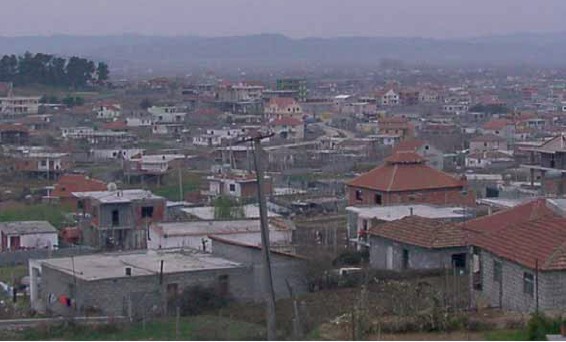
Informal settlements in Tirana, Albania. © Doris Aldoni
Development of Land Administration and Links to
the Financial Markets
– Ms. Dorothy Agote, Permanent Secretary, Ministry of Lands, Kenya
Ms. Agote began by recalling the thousands of Kenyans who were displaced by
recent post-election violence. She stated that the main cause of their
displacement, and of the violence, was land. This emphasizes the importance of
governance issues with respect to land. In Kenya, the development agenda has
always avoided a serious engagement with land issues. Slums are a major social
and economic concern in Kenya, and a major limiting factor in development. The
majority of people in slums are unable to meet their basic requirements. And 60
percent of them are absolutely poor. The influx of youth has compounded the slum
situation. Urban areas are experiencing increased demand for decent housing. A
Poverty Reduction Strategy Paper was prepared that included slum upgrading
programmes. Beneficiaries should be involved in the design and implementation of
such programmes, as they can provide data and detailed insights into their
problems.
Slum dwellers live outside the rule of law and basic legal protection, and
the government is now seeking to promote tenure security issues through a number
of initiatives, including the land policy formulation process, the adoption of
eviction guidelines, land control boards, and land dispute tribunals – all
geared to helping slum dwellers have a basic level of legal protection.
Ms. Agote went on to speak about land administration and links to financial
markets, and how in Kenya the lack of security of tenure weakens the link. This
is a major challenge and impacts on other ways of using land as collateral. The
design of land administration is crucial. Too often a centralized land
administration system is complex, thus compounding the problem of access to
financial markets. And Kenya is a clear example of that problem: systems are old
and do not respond to current needs. The Kenya draft land policy recognizes
this, and the principles for guidelines have been recommended in the draft
policy. In addition, there is a need for gender equality, a lack of which often
blocks women’s access to financial markets. Women are not considered fit to
inherit and hold property. One key is the formulation of the national land
policy, ensuring that it is harmonized, has simple and cost-effective land laws,
and takes into consideration customary and common resource land.
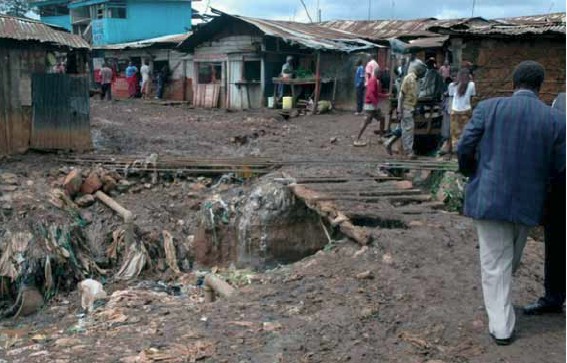
Conditions in Kibera, Nairobi – home to 800,000 slum dwellers, 40% of the
population and the workforce that keeps the city economy going and competitive –
has almost no sanitation, hence an environment of flying toilets, blocked
gulleys and broken culverts – appalling conditions. © Michael Mutter
Social and Economic Impacts of Land Titling Programmes
in Urban and Peri-Urban Areas: International Experience and Case Studies of
Senegal and South Africa
– Geoffrey Payne, Geoffrey Payne and Associates, U.K.
Mr. Payne described a research project that was undertaken in 2006 and 2007
to understand the impacts of land titling programmes in Senegal and South
Africa. A major research issue was whether titling stimulates investment in
housing and property development. One important finding from the study is that
the perception of security is often more important than the titles themselves,
and the promise of titles is more important than their actual delivery. In
addition, titling is not the only means of encouraging investment in housing and
land. Other factors include finances, the location of the settlements, the
provision of services and other upgrading measures, and the regulatory
framework.
In many cases, titling has not increased revenues and in some cases it has
reduced them. In addition, charges are based on land prices and are restricted
by the ability to pay, or can result in forced distress sales. The charges set
according to affordability levels may cost more to collect than is justified.
They may also discourage households from completing the tenure formalization
process. In this regard, action needs to be taken to facilitate transparent land
and housing markets that enjoy social legitimacy.
Mr. Payne offered a number of general conclusions:
- Titling programmes undertaken primarily for economic reasons (e.g. to
secure investment) have failed to realize social objectives (securing land
rights of the the poor).
- Titling programmes undertaken for primarily social reasons also appear
to be of limited value, sometimes contributing to gentrification in urban
areas.
- Programmes undertaken on a small scale contribute to land market
distortion. On the other hand, programmes undertaken on a large scale may
over-burden land administration agencies.
- Top-down, or outside-in, programmes do not work.
- Social legitimacy is vital, as is building on what works in an
incremental way.
Mr. Payne concluded by describing a number of policy implications: assess the
number and quality of land records required and the capacity of the
administrative system; introduce/expand innovative finance mechanisms to provide
credit to the poor; review/relax the regulatory framework for managing urban
land and housing markets; introduce/expand multi-stakeholder partnerships;
encourage a range of tenure options so all groups have a choice; and avoid
“quick fixes”.
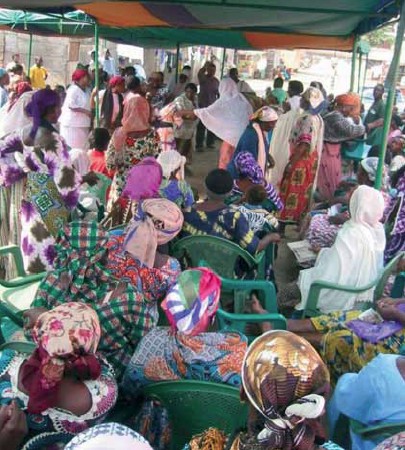
Women’s Savings Group exchange meeting – East Africa meets West
and South Africa. © Michael Mutter
Women’s Access to Land and Finance
– Ms. Ayanthi Gurushinge, Country Coordinator, Slum Upgrading Facility, Sri
Lanka
Ms. Gurushinge began by explaining that women’s land rights are extremely
important, since women’s secure access to land can lead to improved family
welfare and women’s empowerment. There are four main barriers to women’s rights
to land and finance: cultural or legal impediments to acquiring land through
markets, inheritance or transfer; barriers created by intra-household customs
and practices related to marriage; discriminatory policies at the central or
local government level; and poorly drafted laws and regulations governing land
and property rights. She described the three types of land laws in Sri Lanka and
the fact that the laws are not applied consistently or coherently. In Sri Lanka,
the “head of household” concept is more of an administrative term than a legal
one, and the household head is presumed to be the male. This had a major impact
on women during the tsunami: in many cases, even if women had owned property
before the tsunami, all houses were given to the “head of household,” which
excluded them.
Ms. Gurushinge described the Lanka Financial Services for Underserved
Settlements (LFSUS), a not-for profit company that mobilizes resources for
country-wide slum upgrading activities through public-private partnership,
promotes the viability of lending to low-income groups, and provides guarantees
to banks to encourage lending for settlement upgrading. The LFSUS has been
established with the support of SUF, which seeks to develop bankable projects
that promote affordable housing for low-income households, the upgrading of
slums, and the provision of urban infrastructures in cities of the developing
world. She highlighted that housing finance needs to be community-based and
simple (minimal paper work, minimal collateral requirements, flexibility in
repayment, incremental housing financing, etc.). She then presented a list of
strategies to develop women’s access to finance:
- Create housing finance systems that are demand-driven.
- Do not restrict finance mechanisms to housing alone.
- Consider using subsidies as tools to facilitate access to finance.
- Include community savings as part of housing finance.
- Maintain flexibility in loan size and purpose.
- Involve people in every stage of planning a housing finance strategy.
- Minimize rules and procedures and maximize flexibility.
- Explore innovative, community-based ways to provide loan security.
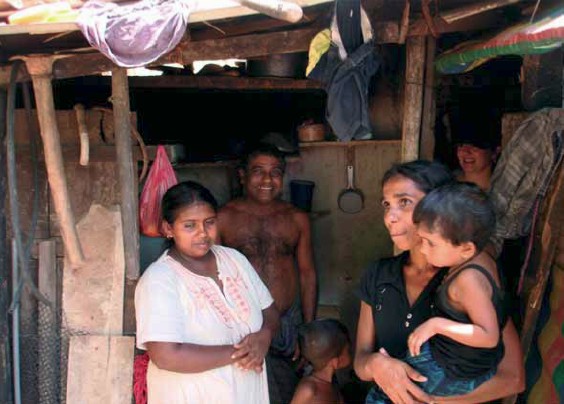
In Sri Lanka, the “head of the household” concept is more an administrative term
than a legal term and is commonly understood to be the man. © Ayanthi Gurushinge
Dialogues: Land Use Management and
Property Rights – Outlining the Roadmap
Four parallel regional “Dialogues to outline the Roadmap to Functioning
Land Use Management for All” were held, focusing on an exchange of
experiences from different parts of the world. The objective was to address
issues specific to each region, as well as commonalities, success stories and
failures, in order to gain a better understanding of how land administration
systems can be improved and property rights established. Key issues suggested
for the dialogue were: factors influencing informal settlements; diversity of
patterns of informal settlement development; and diverse policy solutions,
including a gender perspective. The key to improved housing conditions is open
and transparent markets, but equally important are the steps laid out to create
these markets. In short: how systems can be made inclusive for all.
The following sections provide a summary of the main discussions points of
each regional dialogue, as well as the key issues that emerged.
Group 1 – Southern and Eastern Africa
Participants in this dialogue were from Botswana, Canada, Ethiopia, Kenya,
the Netherlands, Nigeria, Norway, Rwanda, South Africa, the United Kingdom and
Zambia. They drew from their own experiences of implementing upgrading
programmes in the region to discuss what they perceived as the main issues that
arise when trying to apply conventional approaches to slum upgrading. A number
of unintended consequences and reservations were described in the areas of slum
upgrading, granting title to property and implementing micro-finance projects.
Based on their experiences and knowledge of their own contexts, the dialogue
participants expressed concerns that upgrading, titling and availability of
finance would:
- appear to legitimize land invasions or illegal occupation;
- prompt residents to sell their property (or houses provided through a
project) and move to other slums;
- benefit men more than women, owing to the way tenure and ownership were
structured, as well as the way participation in such projects took place;
- leave the underlying causes of poverty unchanged, especially if
individual property rights were granted without support for accessing or
creating employment;
- benefit individuals at the cost of the collective or the community;
- create new landlord/tenant structures, by allocating property to an
individual on plots originally occupied by more than one family;
- benefit existing landlords and displace tenants, since improved service
quality could prompt the owner to raise rents;
- generally disrupt complex and sensitive social networks that exist in
informal land arrangements but which are often destroyed through formalized
processes;
- lead to unaffordable rates and other high costs associated with
ownership;
- be less efficient for governments than simply building rental housing
managed by municipalities, compared to housing which is individually owned;
- in the case of micro-finance for housing, be used for consumption
spending rather than for home improvement; and
- lead to people becoming more indebted through loans and then forcing
them to sell their property at below-market value.
Given these concerns, it was recommended overall that slum upgrading and the
granting of title should not be conducted in isolation from other broader
processes of development, and particular attention should be paid to conditions
of macro-economic growth and participatory democracy. More specifically:
- Urban infrastructure investment which drives slum upgrading needs to be
undertaken within a policy framework of sustainable urbanization and a
broader city strategy.
- Upgrading of informal settlements should not be undertaken on a
settlement-by-settlement basis, but within a broader area-based framework.
- Surveying and registration need to be linked to broader settlement
development and upgrading processes.
- After understanding the macro and local contexts, the granting of title
must be designed to benefit people equitably, especially considering the
needs of the most vulnerable, and share rights between women and men, young
and old, landlords and tenants, and one generation and the next.
- Ownership should be one option, and rental and other tenure arrangements
such as group rights should be made available as viable alternatives to
allow people to make rational trade-offs depending on their situation.
- Titling should be coupled with education around the accompanying
limitations and obligations.
- The objective of surveying and titling (or the establishment of other
forms of tenure) should be to create predictability and to build trust
between people (e.g. between neighbours, between residents and local
authorities, between residents and politicians).
- Creating trust between property owners (or people with other types of
secure tenure) and lending institutions may be a much later development when
property becomes collateral for loan finance, but it is not a sound initial
motivation for establishing individual title.
- Property rights should be enforceable if they are to be meaningful. High
incidences of dispossession of land would indicate that the prevailing
system of property rights is inappropriate.
A number of conclusions for the way forward were put forth in the dialogue:
- Work towards pro-active land use management and planning.
- Build upwards to achieve the density required for the number of people
that need to be accommodated in the limited space available.
- Explore new methodologies for access to finance.
- Work towards decentralizing land registration processes and establishing
local commissions to regulate the process with transparency.
- Consider upgrading informal settlements within a broader planned urban
renewal context.
- Link slum upgrading with rural land use improvement for better incomes.
- Devise simpler titling systems for housing.
- Promote a shift towards a group/cooperative approach to housing
development.
- Capture experiences and disseminate knowledge directly to communities.
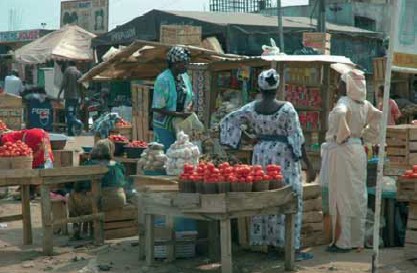
Old Fadama, Accra, Ghana. © Suzi Mutter
Group 2 – Asia and the Pacific
The Asia dialogue included participants with experience from Cambodia, China,
India, Indonesia, Sri Lanka and the Pacific Islands. There was an initial brief
discussion regarding the advantages and disadvantages of land titling, recalling
the recent debate initiated by Hernando De Soto’s book, “The Mystery of
Capital”.
A discussion followed on the legal and institutional pre-requisites for
effective land use management and on whether governments are willing to make a
shift from ‘donorship’ to ‘ownership’. The participant from Cambodia proposed a
number of pre-requisites, including:
- capacity, which is the most important factor, and the need for a new
generation of staff;
- appropriate institutional arrangements (in the case of Cambodia, a
council was set up for developing the land policy, and 17 ministries are
members, reflecting the fact that land is a cross-cutting issue);
- openness to the private sector;
- viewing land reform from a financial perspective, including land
valuation;
- realistic targets for titling;
- dispute resolution mechanisms that are pro-poor, straightforward and not
costly.
The participant from Cambodia also mentioned that with the quality of titles
produced in the country, the security of transactions is very high, and banks
will provide up to 50 percent of the value of the land as a loan. At the same
time, one of the impacts of land titling is that land value increases were
significantly higher and the poor were selling it at a much lower price, with
the result that the rich were capturing the majority of the land value increase
due to titling.
Discussions also revolved around titling vis-à-vis customary and legal
frameworks, with some proposing that the former be assimilated into the latter,
and others proposing that titling begin from customary law and build from there.
The question also arose as to how to make certificates more valid, since in many
areas they are not accepted by banks as collateral, thus preventing poor people
from having access to financial services. It was felt that it is critical to
demonstrate that the poor have the ability to repay and to save, in order for
banks to have a better understanding of their capacity. The need was also
expressed to have systems that can marry access to finance to ever-improving
certificates. How can certificates be made stronger?
The group discussed the need to have incremental approaches to land and
finance access in order to minimize market distortions and put less strain on
the administrative system. In this regard, as a group, people are better
positioned to withstand livelihood shocks and access credit, and certificates
gain in value as individuals create a positive credit history over time.
Building trust was considered paramount. As people achieve a certain level of
income, they gain more confidence in the formal system, and informal systems are
gradually pared down.
The complexities in the Pacific region were also discussed, in particular the
situation of people who are not landless but are not in high-land-value areas.
They move to urban areas, cannot get land and end up in informal settlements. In
China, on the other hand, many people give up their land rights and gain rights
to an apartment, not to a land parcel. One particular problem in China is access
to credit. The financial system is not fully developed, and the government and
banks are trying to learn from other countries in order to perfect legislation
and the mortgage system, with a view to avoiding consequences similar to the
sub-prime experience in the United States.
The role of private financing was also discussed, especially since land is
becoming increasingly scarce. There is a need to reserve a certain percentage of
privately developed land for low-income people; people who had been moved out
should have first rights of access, and private developers need to provide
infrastructure such as schools and clinics.
A number of overall conclusions were put forth during the dialogue:
- Developments are best served by an incremental approach, with collective
loans carefully administered at first, and then moving to individual loans
over time.
- Massive land titling doesn’t work; certificates work better, evolving to
more mature property rights over time.
- People prioritize legal certainty of land rights for the following
reasons: (i) security of tenure/ reduced risk of eviction; (ii) the ability
to pass on their asset to their children; and (iii) ability to access
credit. People need to be able to access credit without having to risk their
land asset.
- Small loans need to be able to evolve into larger loans and then into
some form of mortgage. Communities can increase their power through savings
schemes or by using traditional institutions.

How to assist local community savings groups such as Riverside slums in
Jakarta, Indonesia where residents want to organize their own plan for
upgrading, seeking private sector capital for their new apartments constructed
to be above the flood danger level. © Michael Mutter
A number of issues emerged from this Dialogue session, which included several
participants each from Ghana and Nigeria, as well as others familiar with the
West African context.
Some of the key issues discussed were as follows:
- Collaborative approach. Are institutions of surveyors working in
isolation, or are they bringing anyone else (e.g. service providers) on
board? A collaborative approach is essential.
- Capacity building. There was a strong call for more capacity
building, recognizing the shortage of schools to train in developing
countries, and the need for capacity before talking about any large-scale
titling.
- Diversity of contexts. Nigeria, with 60 states and 25 tribes,
offered an example of the diversity that exists within a country and the
importance of not generalizing solutions. The reasons for slum formation and
development differ, and careful research is required to understand different
contexts. Examples illustrated that slums and informality may exist for
reasons other than – or in addition to – poverty. For example, lack of
transportation can lead wealthier groups to choose to build informally close
to work, even if they own land in rural areas.
- Advantages and disadvantages of titling. Intense debate took
place on the possible advantages of a land title, triggered by Geoffrey
Payne’s presentation. Some thought that land titling must be conducive to
accessing finance, even though it is clear that a poor person in possession
of a land title will not automatically gain access to credit. Communities
need to save and have some form of land relationship that helps them develop
incrementally in an affordable way. Examples from Ghana and Nigeria included
the use of para-legal titles that the financial company would accept to
secure the loan. It was also suggested that one of the negative outcomes of
titling is that it creates a “black and white” scenario – going directly
from informal to titling can obscure the full picture. Assessments and
gender analysis are needed at the outset to ensure that vulnerable areas and
groups are not excluded.
- Taxation. Taxation of property has the benefit of making money
available to improve the environment for the general public. Some kind of
register is needed in order to establish a taxation system, but this does
not need to be land titling. At the same time, in many developing countries
taxation is on the poor, and the wealthiest property owners are not taxed –
this is clearly linked with corruption and weak land governance.
It was agreed that land titling should not be an aim in itself. If there is
no rule of law to support the rights attached to these titles, they are
virtually useless. Good land governance is therefore critical.
It was also emphasized that slum upgrading requires a holistic approach;
facilities and services such as sewage, water and security should not be
addressed individually. In addition, contemporary forms of collective tenure
need to be explored, and more research is needed to build knowledge on its
evolution and impacts.
The dialogue concluded with a focus on the role of local government. How can
FIG work more closely with local governments, including associations of local
government? If local governments do not have the capacity to work with slums,
ultimately nothing will happen. FIG also needs to work more with planners. In
all cases, solutions need to be found locally, and local governments need to
have the will and capacity, and access to information.

Slum Upgrading Facility in Ghana. © Michael Mutter
Group 4 – Central and Eastern Europe
The Central and Eastern Europe dialogue included participants from Croatia,
Germany, Greece, Iraq, Israel, Norway, Russia, Turkey, the Ukraine, the United
Kingdom and the United States.
More than 50 million people in at least 15 European countries are affected by
poor land administration and cadastre systems, with a lack of clarity and
transparency in land tenure and property rights. Lack of clear planning regimes
or a lack of enforcement of existing plans leads to massive illegal construction
in urban areas. The dialogue focused on a number of factors influencing informal
settlements.
A wealth of country experiences and examples were given. In Serbia, one
million illegal buildings have been constructed over the last 20 years, and the
issue is how to bring them into the formal system and register them without
accompanying high fees. In Russia, the speed of building construction is very
high, with adverse environmental consequences since planning regulations are not
designed for dense urban construction. In addition, in suburban cities there is
illegal construction on agricultural land. A participant from Iraq noted that
the country is still suffering from poor land management and unclear property
rights. Updating of cadastral maps is extremely slow, and the information is
outdated, with British maps from 1920 being used.
The issue of enforcement of regulations was intensely debated, with some
participants insisting that the destruction of illegal structures is the best
solution; others felt that such a measure was far too severe. Corruption was
widely acknowledged as a major impediment to enforcement and a factor that was
exacerbated by land management procedures that were not transparent.
The following key issues emerged during the dialogue:
- Informal construction has two principal and different motivations:
construction by poor people for basic shelter; and construction for
upgrading private real estate and for profit, usually in areas where real
estate values are high.
- The term legalization may not be the best term when applied to
addressing informal settlements. Decentralized or environmental upgrading
may be more appropriate to use when talking about acknowledging, in some
way, the existence of “informal” construction or settlements.
- Legalization is not a panacea. It needs to be to be complemented with
environmental improvements and upgrading of settlements, all of which is
time-consuming and costly.
- Land use and planning systems must be developed at the municipal/ local
level, with the participation of individuals and communities. In addition,
taxation is an indispensable tool that should be used to collect revenue to
be reinvested locally so that people see the immediate and local benefit.
Consideration should be given to needs of the taxpayers and not simply to
those of the legal owners.
- Public land administration needs to be equipped with modern tools such
as spatial data infrastructures, cadastre and e-governance in order to be
able to quickly and effectively address emerging demands arising from
urbanization. Moreover, it needs to be simplified to prevent undue delays
that would in itself promote illegal construction. People are willing to
respect laws if they are efficient and respond to their priorities.
- Post-conflict areas require particular attention, as land tenure
security in these areas is particularly threatened, and often in the absence
of public records or responsibility.
- Documentation and recording of property should include legal as well as
illegal dimensions.
- Land use changes may not comply with safety regulations, and attention
needs to be paid to these changes.
- Stable land policies will encourage investment in the maintenance and
upgrading of newly privatized land or property in countries in transition.
- Demolition of buildings is never a popular intervention. Only buildings
which are clear environmental hazards should be demolished.
- Corruption can be minimized through developing policy and regulations
that are clear, unambiguous and transparent.
- Land administration systems need to consider preventive remedies. In
addition over-regulation can be a barrier to affordable housing.

Across Albania, ALUZNI is in the process of legalizing 681 informal zones,
(23,000 ha). ALUIZNI has recorded some 350,000 requests for legalization, out of
which some 80,000 are multi-dwellings apartments and shops. © Doris Aldoni
Day 2 – Just and Sustainable Shelter
Finance Systems
Day 2 began with plenary presentations that outlined how financial
services are expanding to reach the urban poor. Four parallel “Dialogues
addressing various links of the land administration chain” were held, again
focusing on an exchange of experience, but this time from different professional
perspectives. The objective was to enable a cross-cutting development of the
links between individual links in the chain. Participants chose between four
sessions: Practices and Tools; Reinventing Planning; Linking Financial Sources;
and Access to Finance. A wealth of real-world experience was shared from around
30 countries.
This section summarizes the key points made in the Plenary speeches and in
the Dialogues.
Land Administration and Finance Systems
Expanding the Outreach of Housing Finance for the
Urban Poor – A Matter of Cooperation Combined with Sufficient and Appropriate
Due Diligence
– Mr. Michael Mutter, Senior Advisor, Slum Upgrading Facility, UN-HABITAT
|
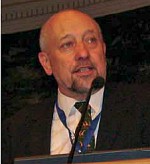
© FIG |
Mr. Mutter opened his presentation with the question: “Why should we
be discussing finance for the urban poor in 2008 when the rest of the
world is suffering a major credit crunch resulting from massive
miss-selling of loans to the poor in North America?” The most
asked-for element in upgrading demanded by slum dwellers is access to
formal credit for loans for them to construct their own houses. As
things stand, poor people cannot afford credit since for them it is
exorbitant. This is because existing housing finance systems are not
geared to their needs. As a result, they fall prey to exploitation by
loan sharks at the informal end of the market, and to the high interest
rates of the formal market, both of which are linked to the perceived
high degree of risk for the lender. |
Mr. Mutter elaborated on the ‘slums investment deficit’ – the
contrast between what poor people can do and put up with in an environment where
they are not formally accommodated or sometimes even acknowledged, even though
they provide the city with its base resources, namely, the labour and
entrepreneurial skills that support the city economy. Currently, the ‘slums
investment deficit’ is lop-sided. The slum dwellers are the investors in the
urban economy and the ‘authorities’ do not keep up with them. The slum dwellers
have incredible resources, and the slums have tremendous unrealized
value. To be productive they need investment. He then provided some examples of
community-led housing finance schemes in Namibia, Pakistan, the Philippines,
South Africa and Thailand.
Mr. Mutter emphasized the growing understanding that the key to
up-scaling the provision of water, sanitation, housing and neighbourhood
development in developing countries is more successful and sustainable where
innovative financing mechanisms are used that involve commercial project loans
coupled with direct repayment elements by the householders themselves on a group
basis. He described the three basics for slum upgrading and prevention which are
core to investment decision-making:
-
Land availability and land security – meaning that once
occupied, the occupants will not be forcibly evicted. In this respect the
FIG’s role in working towards formal recognition of land security in
multiple forms specifically designed around the capabilities of the urban
poor can be seen as part of the due diligence required for finance.
-
Responsibility of municipalities to ensure basic affordable
services – road access, drainage, sanitation and water supplies, etc. – this
may require credit facilities against the revenue generation of the entire
city asset base. Water and sanitation can be seen as an entry-point for
municipal action in slums. Understanding costs is crucial, especially
keeping the cost of construction in check. For example, the cost of a bag of
cement rises daily. But do we need to use so much cement? There are other
construction methods and this information needs to be brought to the local
level.
-
Access to formal and affordable lines of credit specifically
for the slum dwellers’ own projects – such access is dependent upon the land
and services issues being agreed with local authorities as a basis for
community groups approaching the commercial banks for their involvement.
Savings schemes and cooperative structures help banks understand the
containment of risk to which they will be exposed.
SUF has found that such processes can be best achieved through
the establishment of local finance facilities that can offer credit enhancements
or guarantees to act as a stimulus for the application of loan products from
local financial institutions – the commercial banks. In this case the community
savings can be increased by acting as a local guarantee arrangement for
household groups or cooperatives to take loans on a collective basis. These
Local Finance Facilities provide the technical assistance that can package the
slum dwellers’ own upgrading multiple projects with the business plans for the
repayment mechanisms and other finance agreements that can be understood clearly
by the slum dwellers (the ‘clients’) and by the credit committees of the
commercial banks. In addition, credit enhancements can be offered by the Local
Finance Facilities to provide the necessary comfort for the commercial banks to
close the deals with the slum dwellers. This process is called ‘Finance Plus’,
in which the multi-stakeholder board is a problem-solving group able to help the
slum dwellers’ projects gain competitive formal credit through their detailed
‘due diligence’ of the projects.
Mr. Mutter concluded by explaining the difference in approach –
housing upgrading schemes are based on the plans of community groups (as opposed
to individuals accessing bank loans), which creates greater ‘due diligence’ of
the process leading towards the formal credit facilities. This is where a sound
methodology leading towards a Project Business Plan process comes in – and
results in a clearer picture of sustainable financing. This is working in
practice, and is the model needs to be developed and expanded.
|
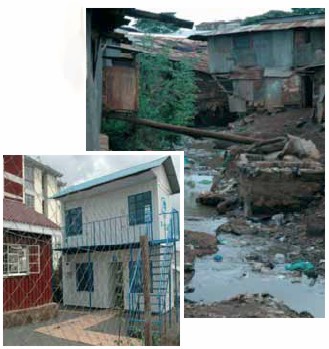
© Michael Mutter |
Kenyan example Point of contact for the community is essential
as part of a new approach to city planning, able to deal with the
problems associated with degraded residential occupancy at the urban
margin, then able to deal with:
- Project Financial Packaging through development of a Special
Purpose Vehicle (SPV) Development Company or Housing Association,
engaging with domestic capital markets and commercial retail
lenders.
This has attracted Rockefeller Foundations for funding. |
|
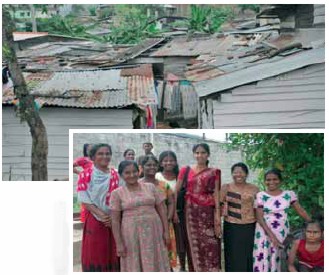
This women’s savings group is linked with the Women’s savings Bank
Federation and slum Dwellers International. they thus have a track
record of full and timely repayments, well able to attract commercial
bank loans for development. © Michael Mutter |
Sri Lanka example Financial packaging for three large-scale
slum upgrading initiatives with the Colombo and Moratuwa City Councils,
Slum Dwellers International and commercial banks:
- Development of a nationally based Local Finance Facility as a
multi-stakeholder not-for-profit company able to package slum
dwellers’ projects and seek commercial loans with the help of local
credit enhancements.
- Expansion of low-income housing products.
- Technical assistance and advisory services to other municipal
slum upgrading projects.
|
|
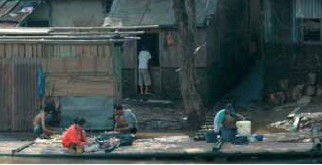
The waterway threads through this Jakarta community. It is intensively
used. Families live, wash and trade from their pontoons, which is also
used as the community toilet facility. © Michael Mutter |
Indonesian example Flood-prone housing areas in Jakarta
requiring technical advisory services to community cooperatives and
commercial banks:
- Financial packaging for city-wide slum upgrading of Province of
Yogyakarta.
- Development of a Local Finance Facility for the City of Solo,
the former Surakarta capital of Indonesia.
|
|
DO |
DON’T |
|
Ensure that financing for slum upgrading is recognised as a priority
within national development planning and as a key investment element
contributing to economic growth. This emphasis should be reflected in a
slum upgrading budget line within national and local authority budgets. |
Don’t rely on one off poverty-focused upgrading projects. |
|
Encourage local and international banks and micro finance institutions
to become active participants in financing upgrading as part of their
core business. |
Don’t rely solely on housing or government finance institutions. |
|
Ensure that guarantees are available to encourage banks to lend to slum
upgrading projects. |
Don’t provide guarantees that support interventions based on political
patronage. |
|
Build investment in slum upgrading on a firm foundation of community
based savings and loan systems and local authority commitments to
provide in kind and monetary allocations on an annual basis. |
Don’t assume that community involvement is best restricted to cost
recovery and loan repayment and that local government has no
responsibility for planning investment in upgrading. |
|
Recognize that financing for slum upgrading requires a mix of short,
medium and long-term loans, integrating finance for building,
infrastructure and livelihoods. |
Don’t assume that one financial product fits all. |
|
Provide mechanisms to blend municipal finance, cross subsidies and
beneficiary contributions to ensure financial viability of upgrading
projects and home improvement programmes. |
Don’t rely on government subsidies or on full cost recovery from slum
dwellers |
|
Develop a process for sharing risk analysis and planning for risk
mitigation and management with all the key stakeholders |
Don’t expect residents of slums to be the only risk takers in developing
new approaches to upgrading. |
|
Plan projects on a mixed-use basis with revenue generating elements such
as saleable residential units and rentable commercial space in order to
maximize financial viability. |
Don’t assume that lending for slum upgrading will necessarily be
asset-based. Where banks do lend for this purpose lending is more than
likely to be revenue based. |
|
Ensure that subsidies are effectively targeted so that the benefits
reach those for whom they are intended and build on the basis of long
term engagement. |
Don’t assume that all the problems of a slum can be addressed quickly
within the framework of a single project. |
|
Recognize that not everyone who lives in a slum is poor. Where an area
upgrading strategy is to be implemented provision needs to be made for a
range of income groups with steps taken to ensure that the poorest are
not excluded. |
Don’t insist that interventions should only benefit low-income families. |
|
Recognize that home ownership is not the solution to everyone’s
problems. Provision for the development of affordable rental property is
an important component of financing slum upgrading. |
Don’t restrict interventions to developments based on clear land title
and private ownership of property. |
|
Make the real cost of finance very clear so that people clearly
understand the commitments they are making to loan repayment. |
Don’t hide the real cost behind misleading promotional messages. |
|
Where appropriate establish local upgrading finance facilities so that
funding is locally available. |
Don’t assume that existing finance institutions will have the capacity
to deliver the full range of financial services required. |
|
Explore options to use land allocation, readjustment and sharing methods
to release finance for upgrading. |
Don’t place unnecessary restrictions on land use Financing slum
upgrading. |
Financing slum upgrading.
Channelling the Global Financial Flows for
Adequate and Affordable Housing
– Ms. Renu Karnard, President, International Union for Housing Finance
|

© FIG |
Ms. Karnard elaborated on how the global financial flows could be
linked to serve the purpose of adequate and affordable housing for all –
based on experiences from India.
She began by describing the role of housing in India, which is a
critical component of the economy since it is the second largest
employment generator after agriculture. In fact, she added, the sector
has grown 30 percent per year over the last five years. At the same time
the total investment for meeting housing requirements until 2012 is
estimated at US$ 90 billion, which represents an enormous challenge.
Therefore, it is all the more imperative to seek innovative housing
finance solutions from the private sector. Currently, the acute housing
shortage has translated into 23 percent of the population living in
slums or squatter settlements. Moreover, only 36 percent of urban
households have sanitation facilities. |
The main players in housing finance are banks and housing finance
companies, which cater to the upper- and middle-income segments of the
population. However, affordability has improved over the last decade: in 1995 it
took 22 times one’s annual income to buy a house in a typical suburb of Mumbai;
today the ratio is five times. The decrease can be attributed primarily to
rising disposable incomes. Nevertheless, housing remains unaffordable for a vast
population. The key reason is the distortion in land prices. The price of land
accounts for almost half the cost of a house. Land is a state subject, and like
any other emerging country, India faces a host of legal and regulatory
constraints that prevent land from entering the market. Other constraints
include lack of clear land titles and lack of a rental market.
To encourage low-cost housing, there could be a stipulation that
all new housing projects have a fixed percentage allotted for low-income
housing, with tax relief incentives for developers. To encourage financiers to
lend for low-cost housing, there is a need for clear land titles, the
introduction of mortgage insurance and better credit data. One of the most
comprehensive policy measures by the government is the National Housing Policy,
which is focusing on economically weaker segments of the population. The policy
encourages in situ slum housing over resettlement, where possible. The
government has recognized that free housing schemes do not reach the intended
beneficiaries, and that low-income households tend to build gradually (often one
room at a time), thus requiring the need for timely credit.
Ms. Karnard concluded by stating that, despite the hurdles, there
is a growing commitment on the part of the government to realize its goal of
“Affordable Housing for All” and to partner with the private sector in order to
ensure that every citizen of India has a place to call home.
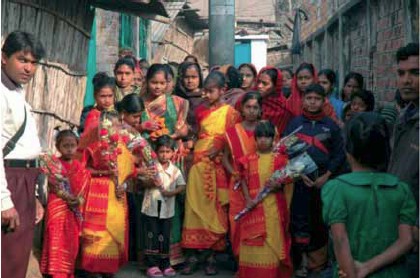
Community groups in Bangladesh, based on daily savings schemes, now formed into
Community Development Committees (CDCs) to contract and supervise all upgrading
work; attractive to local banks who want to contribute to repayable investments
and housing credit schemes via a CDC Trust Fund under local direction. © Michael
Mutter
Land Finance through Land Governance – Expanding
the Discussion of Land Policy during Food Crisis, Climate Change and Rapid
Urbanization
– Mr. Malcolm Childress, Senior Land Administration Specialist, The World
Bank
|

© FIG |
Mr. Childress began by noting that land finance for the poor is
highly exclusionary and cannot be disentangled from the discussion of
land governance in a changing global context that creates new threats
and new opportunities for poor groups. The 2008 World Bank World
Development Report, “Agriculture for Development”, he added, documents
in detail the fact that the ‘bottom billion’ of low-asset peri-urban and
rural groups face the most acute challenges. This group cannot achieve
meaningful participation in existing land markets and cannot access
housing finance. The changing price contexts in energy, food and carbon
make these challenges more acute, but may also offer new opportunities
for ‘win-win’ solutions as multiple sectors recognize the costliness of
land governance failures. |
In the previous era of (artificially) cheap energy, the location
of cities or of fixed natural resources was not considered important. In today’s
context of rising land, commodity and energy prices, location is increasingly
important. This in turn creates tremendous competition between different
interests in land. In this environment, the quality of land governance becomes
critical, determining who has access to what land for what purpose. The
decisions made on these issues will affect, in turn, the distribution of gains
from growth.
At the same time, he added, new opportunities are emerging.
Skyrocketing land prices in developing country cities, for example, create new
opportunities to capture land values to benefit the poor (for example, through
land sharing). Another example is the establishment of markets for avoiding
deforestation, conserving land and resources and establishing new types of
global commons (carbon, atmosphere, oceans, intellectual property, communication
bandwidth, financial space, etc.). Some of these have significant potential to
benefit the poor, particularly in forest and peri-urban areas.
The challenges and opportunities are clear, he added, but getting
traction for poor groups to improve social and environmental outcomes is
difficult. It requires effective land governance at multiple scales – local,
regional, national and international. Land issues are present and critical at
each scale of governance, from parcels, to neighbourhoods, to municipalities,
districts, countries and regions. But we lack the tools and institutions to
successfully manage even small spaces and interactions. New tools combining land
administration and information technology offer tremendous promise for land
governance, but the social and political agreements needed are much more
complicated and often seem out of reach. To make progress in effectively
managing the global commons, he stated, the land governance agenda must engage
with the actors, interests and structures concerned with the exercise and
regulation of power at different scales (including elite, popular and excluded
groups at each scale). Governance specialists and land specialists need to talk.
New paradigms for looking at land governance in the 21st century
may hold promise for creating ‘win-win’ scenarios for territorial health in
which different social groups find profitable and mutually agreeable ways to
share space. One such option is the revaluing of resources through the pricing
and taxation of land in a fully carbon-linked, water-scarce, global economy.
Food productivity and local system resiliency and local environmental services
create new opportunities for income streams for the poor and new sets of
possible agreements around urban, forest and agricultural land.
The concept of Legal Empowerment of the Poor (on which a
high-level Commission) recently concluded its report), may find its strongest
expression in land governance through a focus on inclusive policy development
and the ‘continuum of rights’ and interests in land. This puts a renewed focus
on the inclusion of public lands, communal rights and land management in
relation to land policies and land finance. It also calls for thickening the
institutional context through greater inclusion of the full range of social
actors and the increased recognition of the importance of land by both
environmental and finance constituencies alike.
He concluded by emphasizing that many of the price/cost
parameters under which land finance and land governance have worked in previous
years has changed. Land governance at multiple scales is not the concern of just
one specific technical practice, but rather of multiple social interest groups.
In this way, land value and land financing can be made to work for all, in
particular the poor.
Housing Finance for All – Swedish Engagement in Land
Administration and Housing Finance
– Mr. Dan Ericsson, State Secretary, Ministry of Finance, Sweden
|

© FIG |
Mr. Ericsson explained the Swedish engagement in land
administration and housing finance. He started out by pointing at
historical evidence that the major injustices in the world can be
changed.
“Compassion and anger can be driving forces for those of
us who are eager to push towards justice and equality. Don’t
underestimate emotions in this respect. Dr Martin Luther King didn’t
when he told millions about his dreams. Those dreams may not have been
fulfilled but there has been progress – quite a bit of progress. It is
worth working towards goals that seem unreachable at the time – like
housing finance for all. If we put our hearts and our minds to it, we
too can go far towards our goal. And it will be worth it!” |
Cities in developing countries show that the paradox that
progress creates poverty rings true. Poor people are forced to live in
overcrowded conditions due to rising constraints on their access to land. The
functioning of the urban land market is arguably the most consistent bottleneck
undermining long-term city development.
To change this, the Swedish State Secretary requested existing
actors in the global financial markets to play their parts in a comprehensive
legal, political, social and economic framework for urban land markets. These
actors need to recognize the market at the bottom of the population pyramid –
which consists of close to four billion people. The comprehensive framework, he
explained, is built on the assumption that ownership of property, alone or with
others, should be a human right. A fully functioning property system should be
composed of four blocks: a system of rules that defines the bundle of rights and
obligations between people and assets reflecting the diversity of property
systems around the world; a system of governance; a functioning market for the
exchange of assets; and an instrument of social policy. When such a system fully
functions, it becomes a tool for the inclusion of the poor in the formal
economy, and a mechanism for upward social mobility. But even when a single
component is dysfunctional, the poor are deprived or discriminated against.
The initiative of this Seminar was taken by the two responsible
agencies for land and housing in Sweden – the National Mapping, Cadastre and
Land Registration Authority of Sweden and the National Housing Credit Guarantee
Board. From a policy based on the need for integration, these two institutions
have for many decades developed a way to combat poor living conditions.
He concluded his speech with a reaffirmation of Sweden’s
commitment to this issue. “Sweden has experience in this field, which we are
ready to share with others. We will support responsible actors, linking the land
administration chain and bringing a shared understanding of the way forward. Let
this be known – we are here not just to attend another seminar. FIG has chosen
the Dialogue formula in order to learn from experience and share both successes
and failures. We are here to listen and to learn. We will help bridge the gap
between functioning land markets and functioning financial markets. This work
must continue so that we can come closer to fulfilling the dream I mentioned –
the dream that we all share.”
Putting Innovative Systems for Functioning
Finance into Practice
Innovative Structures for Financing Slum Housing
and Infrastructure
– Mr. P. R. Anil Kumar, Head (Microfinance), Emerging Markets, Barclays Bank
PLC
Mr. Kumar first introduced some innovations to make banking
easier, including credit cards and home and personal loans. However, these
innovations are not widely used in slum areas because there is often no proof of
identity and no proof of address for loans. Furthermore, banks and housing
finance companies perceive such innovations as too risky, since the transactions
carry high operating costs with low value and require longer-term exposure.
Microfinance institutions are wary because of the difficult of creating groups
for repayment assurance as well as the issue of the long-term context.
He then went on to describe a number of successful examples,
including the Society for the Promotion of Area Resource Centres (SPARC) housing
model in Mumbai, India, in which the perquisites include urban land that is
available for rehabilitation, and a good “transferable development rights”
market (i.e. the right to construct more for a given land area). The
stakeholders include NGOs, land owners, inhabitants of the land, the government
and banks. He also spoke about the SPARC sanitation model, in which 300 toilet
blocks are being constructed through an escrow mechanism with the municipality,
and with operating costs funded by the community.
Another example he gave was the Johannesburg Housing Company in
South Africa, which is a rental housing model that seeks to refurbish relatively
older buildings and lease them to clients. The loan component comprises about 60
percent of the project cost, and the equity component comes as a grant. Both the
loan and building maintenance are paid for from rental receivables, and rent
collections have a track record of almost 100 percent.
The final example Mr. Kumar presented was the Kudumbashree
community housing model from Kerala State, India, in which government machinery
is used to create community organizations and build capacity, thus reducing
costs and risks. The bank then lends based on its credit assessment, and the
government facilitates the bank’s linkages with the community. Individual loans
can be taken for up to US$2,500. To date, more than 15 banks have participated
in the model, with over 100,000 houses financed and with very high repayment
rates.
Mr. Kumar concluded his presentation by emphasizing that any
workable solution will need to incorporate a combination of both free market and
subsidy solutions. He also indicated a number of key enablers: bridge funds;
partial guarantees; sensible use of grants as revolving funds/bridge funds; and
using subsidies and government participation in capacity building.
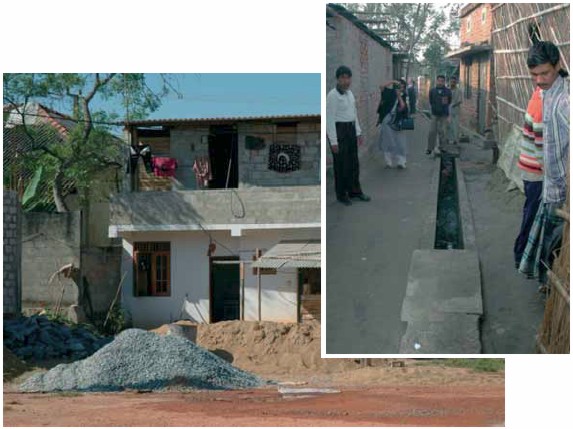
In Sri Lanka slum dwellers, as above, have been able to build their own new
houses, with technical and financial assistance. © Michael Mutter
Local Finance Facilities: What They Are, Why They Are
Important, and How They Work
– Ms. Ruth McLeod, Emerging Markets Group
Ms. McLeod began by describing the “Finance Plus” Facility, which
brings together key players involved in city and national slum upgrading
strategies to address the challenges of financing slum upgrading. The Facility
functions include providing a means to blend different funding to maximize
affordability, and generating data and information for planning and monitoring
slum upgrading. The stakeholders are comprised of government authorities,
traditional authorities, local government, civil society and market
representatives. The Facility provides three types of assistance:
-
Loan guarantees to facilitate access to commercial bank loans
-
Technical assistance to ensure the development of bankable
projects and programmes
-
Catalytic grants to provide critical inputs for successful
project planning and implementation.
Ms. McLeod explained the services offered, sources of funds and
types of initiatives provided in the three countries in which the Facility
operates: Ghana, Indonesia and Sri Lanka. All countries receive the full
complement of services, which include guarantees for wholesale and project
loans, technical assistance for project design and loan negotiations, and grants
for initiating projects. Funding sources include SUF, and local and national
government, although the latter is source only in Sri Lanka. Initiatives are
either planned home improvement programmes or planned area improvement projects.
Ms. McLeod concluded her presentation by briefly describing some
of the main lessons learned through the establishment and operation of the
Facility:
-
Local finance facilities generate commitment and focus on
city-wide slum upgrading.
-
There is great potential for long-term and more complex slum
upgrading initiatives to be channelled through facilities using the “Finance
Plus” approach.
-
National- and municipal-level facilities help to stimulate
project ideas.
-
There is a long delay and high fall-out rate between project
concept and implementation.
-
Rising interest rates are interfering with affordability
(particularly in Sri Lanka).
-
Community savings and loan systems are a crucial element.
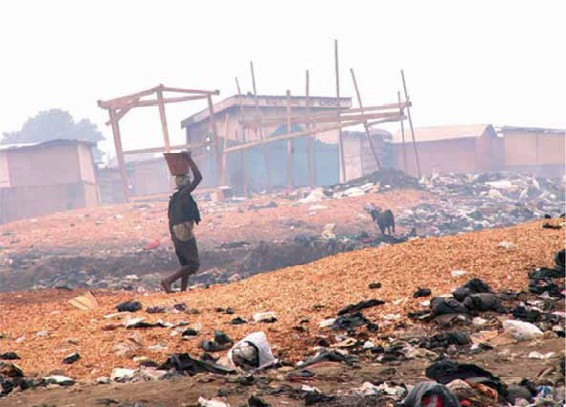
© Ruth McLeod
Four parallel dialogues were held to address the various links in
the land administration chain. The following sections provide a summary of the
main discussions points of each Dialogue, as well as the key issues that
emerged.
Dialogue 1: Land management practices and tools and
links to efficient finance
The dialogue was opened by two slide presentations: the Social
Tenure Domain Model (STDM), presented by Chrit Lemmen; and the Gender Mechanism
of the GLTN presented by Åsa Jonsson.
Chrit Lemmen began his presentation by emphasizing the fact that
land professionals generally recognize that the existing tools supporting land
administration are not pro-poor. He went on to describe a project to develop a
Social Tenure Domain Model (STDM) for land administration. The STDM covers land
administration in a broad sense, including both spatial and administrative
components. In conventional systems, it is possible to relate names/addresses of
persons to land parcels via rights. The STDM, by contrast, relates fingerprints
of a person to a co-ordinate point inside the land in use by that person, via a
social tenure relation. The idea is to be able to map land rights and claims in
a context in which there are many types of statutory, customary and informal
land rights and claims. The STDM makes it possible to put rights into a system
which are not registered rights, nor registerable, and are claims that need to
be adjudicated both in terms of the “who”, the “where”, and the “what type” of
right or claim. From a land and finance perspective, a functional STDM creates
the possibility that a continuum of land rights can be documented, from less
secure to more secure, and the financial markets could price that relative
security into a new generation of loan products explicitly designed for the
poor.
A lengthy and multi-faceted discussion was held on gender,
including the fact that many women still do not have the right to hold a title;
that women often are not recognized as a de jure head of household even though
many women are in fact the head; that female land ownership may be as low as 5
percent (and less) in some countries while it is women who mainly work on
agricultural land with little benefit from the produce; that customary laws and
practices often discriminate against women; and that education is critical for
women to know and apply their rights, and for them to be able to join land
professions and decision-making bodies. It was agreed that one of the most
important elements is to have appropriate laws and policies in place, including
the fundamental one of allowing women to own land, and to make sure that these
are implemented. It was concluded that to enhance gender-responsiveness, work is
needed on many fronts at the same time.
A number of country examples were highlighted related to gender
and land management practices:
-
In Lao PDR, collaboration with the Lao women’s union has
ensured that a woman is always present in discussions on property to inform
households on gender dimensions. Results of women’s empowerment have
emerged: women with titles in their name have increased from 20 percent to
30 percent, with an additional 26 percent having joint titles.
-
In Sumatra, Indonesia, customary practices are matrilineal,
which means that inheritance passes from mothers to daughters. It was noted,
however, that multiple systems are in place, at times in parallel, which
need to be fully understood.
-
In Ghana, both husband and wife are registered. – In Malawi,
everyone has the right to own land.
-
In Rwanda, the issue of gender was continually raised during
the process of establishing the constitution and land policy. As a result,
land-related institutions have a more balanced gender representation.
-
In Kenya, although rules specify that local institutions and
land control boards should have 30 percent representation by women, the
rules are not enforced. Similarly, although the land policy specifies that
there should be legislated land dispute tribunals, these rarely support
women. Thus, when a man dies, the property often passes on to his relatives
rather than to his wife.
Discussions also centred on the significance of effectively
collecting municipal fees. Examples were cited from Ghana, where local
municipalities only have the capacity to collect 20 percent of the total fees.
It was noted that if they could collect 90 percent they would be financially
self-sufficient. It was suggested that rather than looking at other means of
innovative financing, it might be more appropriate to explore means of improving
collection. A number of country examples were again provided.
-
In Kisumu, Kenya it was estimated that only 20 percent of the
revenue is collected. The advantages of enumeration were flagged, where land
data are collected in cooperation with NGOs using forms to record land users
linked to satellite images to collect spatial data.
-
In Ghana, only 22.5 percent of the revenue is currently being
collected. It was reiterated that land revenue collection needs to be
decentralized. The need for a cadastre was also mentioned, and steps were
shared on how a land information database can be set up at the municipal
level, which can be monitored by the municipal assembly.
This led to discussion on what type of information is required
for tax collection. It was noted that in informal settlements it is not possible
to conduct surveys in the same way as they are conducted in formal areas.
Scaled-down options for collecting information need to be explored, with simpler
and quicker methods. In this context, the important question arose as to who
owns the problem of lack of information – is it the community, local governments
or land owners? In addition, back-up systems must be in place for such
information.
A point was made that there is too much focus on upgrading rather
than on preparing for urbanization. In this regard, revenues can be used to
avoid new informal settlements in the future by proper and longer-term planning.
The dialogue ended with an emphasis on the need for political
will and technical expertise.
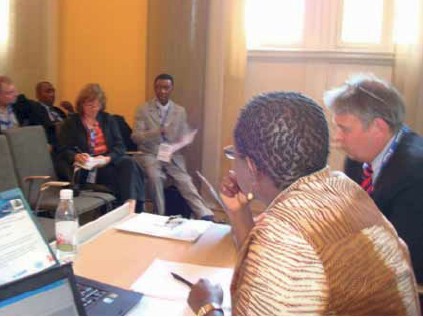
© FIG
Dialogue 2: Revisiting planning: Cutting the costs,
involving the rights of the poor and enabling adequate finance
The chair of this Dialogue, Mr. Geoffrey Payne, began by posing
the question, “How do we persuade those who do not work in cities that they are
the engines of social and economic development?”. He gave an example of Mumbai,
which holds 1.5 percent of India’s population but contributes 30 percent of all
central government revenues. These revenues form the basis for rural development
programmes, so healthy, dynamic cities are vital to rural development, yet
policy makers do not seem to accept this. There are a range of conferences and
publications that have generated the approaches needed to create successful
cities. However, these approaches are not being adopted and implemented at the
scale and speed needed.
One reason discussed was that politicians, senior administrators
and the commercial elite are benefiting sufficiently from the status quo and
therefore ignore the information that is available. Therefore, a major issue is
how to re-invent planning to mediate between public and market interests, and
how to de-link land interests (of politicians/elite) from planning. An example
was given of South Africa, where attempts are being made to transform segregated
cities. However, high land values in good locations consistently exclude the
poor and force the authorities to develop low-income housing in peripheral
locations far from job locations.
State planning and coordination were also discussed. An example
was given of Lusaka, Zambia, where legislation exists but is not enforced.
Informal settlements were upgraded but the infrastructure is not maintained. In
this regard, it was highlighted that the best planning is done by the slum
dwellers themselves. Mobilizing them is not difficult, and if the service needs
are articulated by the people who live there, it becomes their project – they
get what they want, and resources are used to the maximum. By involving the
community in “bottom-up” planning, less information is needed for planning by
professionals, as the local people know their area. In addition, stakeholder
participation leads to local conflicts being resolved within the community.
Local distribution of money to communities helps realize their locally defined
goals.
It was also pointed out that megacities need information for a
broad overview of their challenges, and that planning needs to be long term, for
example ten years. The link between detailed planning and large area planning is
missing.
The dialogue also focused on decentralization and people “hiding”
from taxation. Development broadens the base for property tax, and this tax
raises funds for decentralized functions. Information is needed for collecting
tax, appropriate systems are required for the redistribution of resources.
Taxation should also capture some of the value that is created by society. In
other words, if the local authority provides new roads or services, this
increases property values and should therefore generate more revenues. However,
as residents of informal settlements are usually poor, it is not fair that they
should have to develop through their own financing (e.g. micro-financing). There
should be systems for re-distributing wealth. The poor are willing to pay taxes
if they see benefits. An example was given of Lusaka, where there are campaigns
for taxation. The public is informed, and community members understand the need
for taxation.
Efficient taxation and efficient distribution are important. If
the wealthy are taxed too high, they leave the area. Therefore, there is a limit
as to how far redistribution can go. In Ghana, for example, slum upgrading led
to increased property tax revenue. Taxation is democratically determined, but
politics and policies do not drive development – the market does. In this
regard, transferable development rights is a good example of how governments can
guide the market rather than fight the market. Infrastructure can be financed by
selling land rights “above” the infrastructure. For instance, shopping areas and
offices built over railway stations generated sufficient revenues to finance
major infrastructure works in Mumbai and Navi (New) Mumbai.
To help the poor within market economies, an example was given of
London, U.K., where a rule was implemented whereby any commercially based
residential development should include low income housing for 50 percent of the
development. In London, this is feasible, since institutional capacity is in
place for enforcing the rules. However, such enforcement capacity is not
universal. Another example was given in South Africa, where 100,000 houses per
year have been built. The problem in many developing countries, and even more
developed ones like South Africa, is that governments generally lack an
understanding of where and how much they can influence market-based decisions.
Policy makers also overlook the fact that the poor build incrementally and not
all at once.
Two types of planning are needed: development to meet the needs
of existing settlements and populations and development to address the needs of
future populations. For existing settlements, planning/upgrading is incremental.
As upgrading may be the first contact people have with officials, confidence
must be built between communities and the public sector. It is also important to
accept that starting incremental developments requires follow-up and that poor
people usually cannot provide input into the upgrading other than their labour.
Information is indispensable for community-based planning. An
example was given of Hyderabad, India, where information kiosks or E-Centres are
making information available to the community through Internet points that are
serviced by young government employees. Forms for all sorts of needs (passport
applications, driving licenses, building permits, etc.) can be printed and
processed in the same way that a courier service offers. Information on what is
being planned by the authorities is freely available, thus helping bridge the
information divide. The concept of “m-government” (mobile) should also be
promoted. Through mobile telephones, government officials can improve
information exchange by disseminating information, warnings, etc. quickly and
easily.
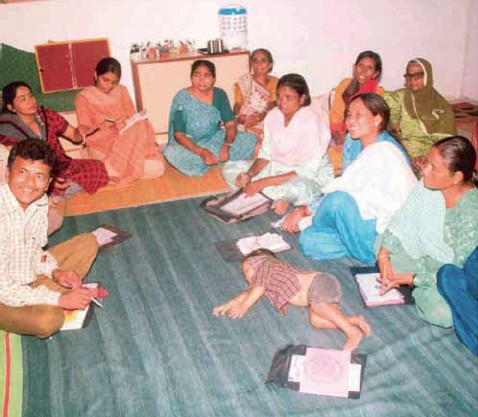
Ahmedabad Municipal Corporation (AMC) project in India has shown that slums can
be
comprehensively improved, slum dwellers will contribute. © I. P. Gautam
Dialogue 3: Linking the financial sources
Participants from ten countries engaged in this dialogue,
including representatives of the banking, public and academic sectors.
A short presentation was given on the World Bank Global
Partnership on Output Based Aid and its work in connection with mortgage-backed
securitization and subsidy schemes. Efficient subsidies should govern the
sustainability of the market, with onetime subsidies for the connection, and
additional subsidies for access to services for the use of them. The
presentation also posed the question, “How do we link the various financial
sources and how do we link local sources with the global financial market?”
The role of the state versus the market was singled out as a key
issue. The group was then divided into two, one focusing on “private” concerns
such as savings schemes, housing loans, remittances, microfinance institutions
(MFIs) and microcredit, and the other on “public” concerns such as tax policies
and other core issues.
A number of country experiences were described. For example, Hong
Kong had slums 15 years ago, but not any longer. The problem was said to be
solved, not simply “relocated”. The solution was the building of a more compact
city, with high-rises, and in a public-private partnership. Government provided
land and the private sector provided housing. Government also reclaimed a lot of
land that had been trespassed. Initially the flats were rented, but since the
1980s some have been available for purchase. Prices have risen dramatically in
this period.
In Ethiopia, the government uses two approaches: setting the
rules for private participation and providing condominium houses, which has been
a good experience. Abolishing slums has been concerned with changing the
horizontal city into a vertical city. Vertical cities save land and generate
revenues. Property rights are very important.
As for the development of slums in Africa, the basic problem is
corruption. Greed and need are both root causes. The government’s role should be
to provide incentives for housing cooperatives and create an enabling
environment for low-interest bank rates. In addition, it still remains unclear
whether MFIs in much of Africa will invest in long-term loans – loans for a car,
yes; for a house, no.
In Indonesia, the government usually has a planning monopoly. For
informal settlements, it is very difficult for poor people to come together and
invest in their infrastructure. The government needs to conduct the initial work
to improve roads, water, sanitation, etc. In this way, the value of the houses
increases, and it then becomes possible to gain access to credit from the
commercial banks. However, this is very much dependent on local conditions, and
it is still generally impossible for local communities to mobilize enough.
Moreover, it is difficult to envision private companies being part of the
solution when it comes to informal settlements, where there are often extremely
poor people living on land whose value is very low. In these situations,
government or local subsidies are needed.
The representative from Hong Kong explained that the national
government together with local government should form artificial companies.
Public-private partnerships should be one unit. Technical and managerial support
should be given at the outset and then phased out. There should also be
three-party agreements, including government, community and private operator.
However, the question arises as to where the private actor will find its
incentives. In addition, a functioning private sector is not possible if the
public sector is not working. For example, in Nigeria there is no electricity,
and therefore the banks are not going to provide loans because the risk is too
great. MFIs are just beginning to function in Nigeria, which is an outflow from
the banking consolidation conducted in the country in 2005. Before, there were
too many community banks, but currently there is a maximum of 25 banks. There
are no mortgage institutions or subsidies, and therefore loans are given at
prime lending rates. Only people who are working or self-employed have the
necessary assets to borrow. In addition, it is taken for granted that borrowers
will have a good title documents.
The dialogue concluded that the involvement of both central and
local government is needed to minimize corruption, support infrastructure,
security and title issues, and provide subsidies. This could provide incentives
for the private sector to come in. All of this will need to be integrated within
the planning process. The international community also has an important role to
play by putting pressure on national governments when they are corrupt,
especially when money is diverted. The international community could also
provide the long-term financing required to address housing.
Dialogue 4: Expanding the outreach of housing
finance for the urban poor
The session included participants from Angola, Egypt, India,
Nigeria and South Africa.
It began with an exchange of country experiences. The participant
from Nigeria explained that less than 5 percent of the population’s home
construction is financed through mortgages and that financing is generally
accessible only to the upper middle class, since equity must be about 25 percent
of the cost of home construction or the purchase price. Moreover, Nigerian
professionals have not managed to convince the three tiers of government to
create a conducive environment for slum upgrading investment. One option would
be to link to organizations of the urban poor and encourage business investment
in the area (small poultry farms, fishery, farming, etc.). However, support from
external organizations would be needed to generate the political will for the
investment.
In India ten years ago, there was only one serious mortgage
lender, whose prerequisites included a formal job, with a salary deduction for
the mortgage payment. This translated into two types of borrowers: the wealthy
and people seeking to launder black money. A dramatic shift took place when
banks became willing to take construction-related risks and slowly moved to
broadening the market. Today a person whose monthly salary is US$ 500 can
receive a formal loan for housing under construction. The bank assesses the
construction risk, the customer is then appraised, and a mortgage decision is
made. This is still asset-based lending and the key consideration is the
security/quality of the asset. For the bank, the main concern is whether it can
sell the asset to recover its investment in the event the person defaults.
Egypt has a somewhat similar experience in that 15 years ago
commercial loans were available but not residential loans. As commercial lenders
became more comfortable in the market, they started to become willing to create
new and different products, which is a promising first step.
In Angola, where two thirds of the population resides in large
cities, the construction sector is strong, including informal construction,
which produces good-quality housing. Recently, government structures are being
created for housing finance, and new laws are under preparation for land
management that cover state and private land. There are some community groups,
but no political governance structure to coordinate them. Moreover, communities
have not yet come together to effectively lobby for their interests. There are
strong political movements towards investment in infrastructure and
urbanization, and for surveying and land management, as well as for transferring
state-owned houses to private ownership.
The dialogue then turned to the key factors required to create an
enabling environment for lending for low-income housing construction. They
include:
-
Macro-economic stability. Fixed-rate loans are not
feasible in a situation of rising interest rates. Loans are restricted to
short-term incremental lending, and incremental construction. Home
improvement loans are possible, but not for three-story high-rises or
multi-year loans.
-
Collateral. Mechanisms to recover their investment
(foreclosure, group guarantee) are perceived to be essential for banks.
-
Legal framework. There need to be means of protecting
investments against theft or fraud.
-
Financing sources. Financing sources could also
include affordable funds, including pension funds. The macro-economic
environment is improving in many developing countries and there are more
diverse opportunities for investment, including housing finance. In other
countries, inflation is rising and needs to be considered in the calculation
of the loan interest rates.
There was a fairly common perception that mortgage markets were
not an effective solution for the urban poor to access housing. There was a
preference for lending to organizations of the urban poor. In addition, there is
a widespread assumption that housing loans are consumption loans, whereas many
housing loans are in fact small-business loans, as home-based businesses are
established.
A number of key messages emerged from the dialogue:
-
Macro-economic stability is critical. The annual inflation
rate must be 10 percent or less for mortgage finance to be viable.
-
Mortgage-based lending instruments are not appropriate for
the urban poor living in a context of rapid urbanization, lack of land
title, and inability to foreclose. The most appropriate profile for
low-income housing loans is not asset-based lending (collateral-based); a
history of repayment is more critical.
-
Historically, subsidies have played a significant role in
generating markets. These are not a best practice, but they do open up
markets to new sources of finance. Often an incremental approach is required
to build lender comfort. Commercial loans can start more quickly; loan
guarantee or insurance systems are other options at the early stage to get
the system functioning.
-
An incremental approach is needed for building houses and
markets. A poor person cannot simply go out and arrange bank financing for
housing. Small steps are necessary.
-
Groups or cooperative models are key to accessing finance and
reducing the risk perception. Groups can provide a guarantee for repayment,
with members of the group able to cover an individual’s instalment if one of
them falls short in any given month.
-
Group savings and loans systems are critical. Over time these
systems can become larger and more sophisticated and help build financial
literacy. Savings are indispensable to prove creditworthiness. In this
regard, groups can strengthen and leverage individual savings.
-
There is a need for political will to create an enabling
environment for private investment in slum upgrading. Governments must
practice restraint: borrowing less for their annual budget and helping to
bring inflation down.
-
There may be a need to create new institutions to meet the
demands of the urban poor clientele, since it is difficult to convince banks
to move into new markets. The Committee on Development Information (of the
United Nations Economic Commission for Africa) is one model: group lending
is established; an upgrading or development project proposal is put forward
and never linked to the commercial financial sector, depending instead on
government capital.
-
Secondary mortgage markets and insurance schemes may also
contribute to broadening access to finance for the poor. Large loans would
be needed, and perhaps spread over multiple countries, but there is a
question of capacity in domestic banks.
-
Another option is a shared ownership scheme. For example, a
teacher pays rent on three quarters of the unit to a housing association and
over time can increase his or her equity share. Such a market would require
a strong regulatory framework.
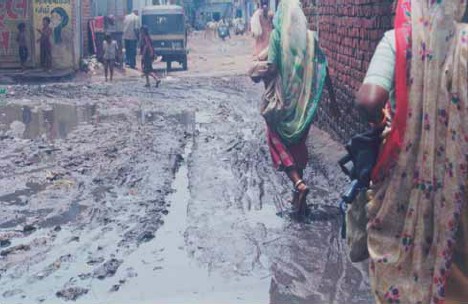 |
|
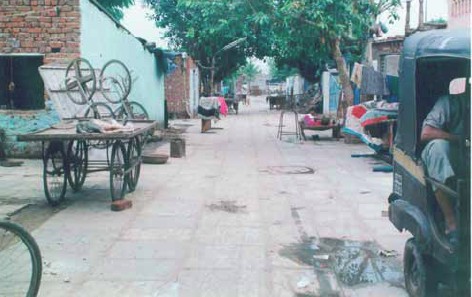
An example of upgrading project in Patan Nagaar, India, situation before
and after the project.
© I. P. Gautam |
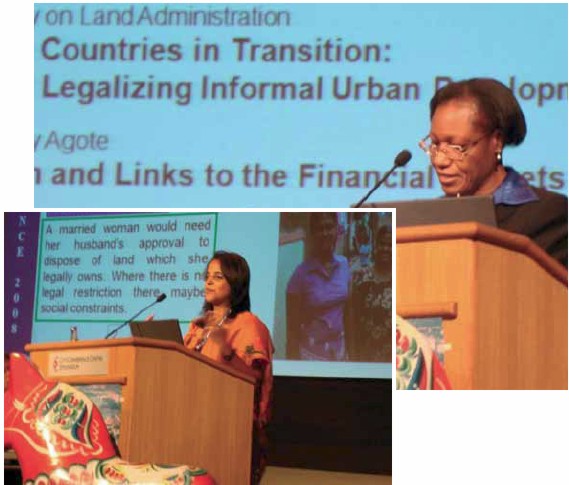
© FIG
As partners in the GLTN and with financial support from Sida,
UN-HABITAT and Lantmäteriet (the National Mapping, Cadastre and Land
Registration Authority of Sweden) jointly coordinated a gender component during
the two-day Dialogue. The objectives were to sensitize participants on gender
dimensions necessary for any discussion on land; provide concrete examples from
projects in Africa and Asia where women play a critical role in the slum
improvement response – including innovative financing – and/or where land tools
have been gendered; and enable practitioners to strategize on how to more widely
share these experiences within their own countries and globally.
Six participants provided insights on gender issues within
existing land tenure systems in Africa (Ethiopia, Ghana, Kenya, Rwanda and
Zambia) and Asia (Indonesia, Sri Lanka). The participants each provided a
background paper (available on
www.justnsustshelter.org) and delivered presentations and inputs in various
forums over the two days.
An assessment of how to best integrate gender into these kinds of
forums, and a roadmap for possible future collaboration, was discussed during a
wrap-up meeting on 18 June. There was consensus that more needs to be done to
ensure that gender issues are profiled throughout meetings and events of this
kind – from the opening statements to the selection of topics in dialogues and
working groups.
It was agreed that the problems related to slums clearly have a
gender dimension and many slum dwellers are women with special concerns.
Concerns about such issues as prostitution and HIV/AIDS are serious development
constraints and need to be addressed within a gender-responsive context. Social
issues, which are root causes of poverty, also need to be addressed, otherwise
any effort to reduce poverty will not advance. The heterogeneity of women also
needs to be more deeply addressed, and move beyond just talking about men and
women.
A number of important country experiences were then highlighted:
-
The complex nature of customary laws was raised, whereby many
development partners and human rights agendas support these systems, yet
such customs also often include negative practices such as discrimination
against the girl child. Discussions on human rights need to be synchronized
and the final impact on the ground is paramount.
-
In Ethiopia, customary laws still exist and women are
discriminated against. The court is often corrupt and favours men. The
institutional set-up needs to be refined.
-
In Rwanda, more than 53 percent of households are headed by
women, and there are even children heading households. Given these
situations, it is critical to think about an appropriate policy based on how
people live in reality, which requires gender responsiveness, and to reflect
that reality in the Rwanda National Land Policy.
-
In Kenya, one of the reasons the draft constitution was
rejected was women’s inheritance. Even women themselves voted against more
inheritance rights for women. It was reflected that Kenyans had not
sufficiently raised awareness of this critical gender aspect, and had left
it to NGOs to put it on the table, rather than senior government officials.
How can we counter these images and what strategy should we use? It was
agreed that more case studies and documentation on these kinds of
experiences are needed.
At the close of the meeting, a number of ideas were put forward
on future collaboration and next steps, including:
-
Given the success of savings and credit schemes managed by
women for micro-financing, it was questioned if this also can be transferred
to land rights, e.g. move from common titling of property to property
information mainly in the name of women.
-
Create gender information/training campaigns as a joint
Lantmäteriet–Swedesurvey–UN-HABITAT initiative. These should focus on
advocacy and make use of existing training modules (e.g. those already
developed by Lantmäteriet).
-
Identify and transfer local needs and expertise, being
careful to include NGOs with strong community-level links; and
-
Encourage further research, especially on the gender and
HIV/AIDS nexus in Africa.
The gender issue is also one of the core values and priorities of
the Global Land Tool Network stating that every tool must be gendered, as must
the process of tool development. See the GLTN flyer on Gendering Land Tool
development:
www.gltn.net/images/About%20GLTN%20downloads/gltn_gender_060612.pdf.
Wrap Up and the Way Forward
The wrap up of the seminar was organized to summarize the key
points for moving forward the process of “improving slum conditions through
innovative financing”.
Three broad areas were discussed that in particular would assist
poor people in gaining a recognized foothold in the urban development process.
They are described in the sections that follow:
Emphasizing ‘incremental’ approaches that suit the poor
The concept of doing things in stages is far more suitable for
poor people, since it corresponds to their approach to life in general. However,
this concept needs to be seen in a context of conforming to the formal systems
of land, services, construction and finance within a city-wide and nation-wide
framework for sustainable urbanization. In this context, the following
attributes to prospective ‘pro-poor’ policies can be adopted:
-
‘Intermediate’ forms of land title – these can help to
build confidence, and serve to provide security of tenure and/or serve as
steps on the way to more formalized land rights, which may take time; this
is more a process of non-eviction, but also needs to take account of women
as equal land rights holders through such mechanisms as joint ownership of
land;
-
‘Incremental’ construction – working towards a formal
recognition of the process of building part of a house at a time, being the
affordable way in which the poor build for themselves and keeping cost of
construction low;
-
‘Incremental’ finance – working towards a formal
recognition of better access to formal credit for the urban poor in ways
that keep the process affordable by using local micro-finance loan processes
within cooperative-type financial intermediaries; these relate to the larger
formal project loans from banks for ‘bankable’ upgrading and new housing
projects developed by the urban poor themselves with the assistance of local
finance facilities and are designed to be problem-solving multi-stakeholder
bodies that incorporate commercial banks, government, professionals and the
slum dwellers organizations.
Recognizing that collective approaches that suit the poor are financially
viable
International experience shows that cohesive groups of low-income
residents are better able to undertake the painstaking groundwork necessary to
design and agree on ‘bankable’ upgrading and housing projects.
Savings schemes amongst the poor that are women-led can lead to
recognizable common interest groups for housing that become the basis of more
formal housing cooperatives able to utilize the savings as instant collateral
against new formal credit arrangements from commercial banks, which view women’s
savings as a sound evidence base for the affordability of their housing
projects. In addition, collective projects put together by women’s groups are
attractive to commercial banks since they reduce transaction costs and offer
controls to perceived risk.
Recognizing processes that make land markets work for the poor
In various countries, innovative planning instruments have been
used that provide specific designations of land for poor people and have
influenced the local land market in such a way that the urban poor are
recognized and can benefit from the regulatory frameworks within a municipal
context. These ideas need to be supported and expanded through:
-
Using innovative planning instruments such as transferable
development rights (as used in Maharastra, India) that can increase plot
ratios with an element of increase that can be traded by the slum dwellers,
and designated planning zones and plot sizes that favour only the slum
dwellers and urban poor;
-
Using very local (e.g. Ward-level) development plans (as used
in Lusaka, Zambia), thus imparting decision making, ownership and crucial
implementation and maintenance processes;
-
Making sure that ‘planning’ is for the future, not the past,
and thus is able to keep pace with the slum dwellers – this means planning
for enough new land designations for the doubling in size of
developing-country cities every ten years, with sufficient land for
low-income residents, both existing and newcomers, be they migrants or new
family members.
-
Strengthening the quality of land governance to ensure that
decision-making includes the perspectives of all relevant stakeholders, and
that the decisions made also serve the needs of the poor.
The FIG/UN-HABITAT seminar attracted new delegates to the FIG
Working Week, broadening the discussion from land professionals to a
multi-discipline dialogue between land professionals, architects, planners,
economists, finance experts and social scientists. The dialogues brought
together more than 120 leading actors from the public, private and
non-governmental sectors working on land and housing finance issues. Intense
discussions revealed that a lot of common understanding existed on the way
forward. Several options were tabled for future action:
-
Convene consultations in select cities involving land
professionals, finance experts, local authorities and the urban poor to
identify opportunities for stronger collaboration to develop new loan
products that meet the needs of all actors.
-
Conduct more detailed research into the global experience and
good practice in providing access to housing finance for people who have
intermediate forms of land tenure.
-
Bring experiences together in usable formats and publications
both for the urban poor themselves and for their advisers and advocates,
using Internet with local interpretation (language and technical) and local
guidance.
-
Encourage the inclusion of these issues in the curriculum for
land surveyors and land-related professionals at the forefront.
-
Encourage development of mentoring programmes for young
professionals that aim to achieve increased awareness of land issues in this
broader context of a huge land-based expansion of low-income urban dwellers.
Copyright © United Nations Human Settlements Programme (UN-HABITAT) and The
International Federation of Surveyors (FIG) 2008.
All rights reserved.
United Nations Human Settlements Programme
P. O. Box 30030
00100 Nairobi GPO
KENYA
Tel +254 20-762 3120 (Central Office)
www.unhabitat.org
The International Federation of Surveyors (FIG)
Kalvebod Brygge 31–33, DK-1780 Copenhagen V
DENMARK
Tel. +45 38 86 10 81
Fax +45 38 86 02 52
E-mail: FIG@FIG.net
www.fig.net
Published in English
Copenhagen, Denmark
ISBN 978-87-90907-70-9
ISBN 978-92-1-132013-8
HS/1034/08E
Published by
The International Federation of Surveyors (FIG)
DISCLAIMER
The designations employed and the presentation of material in this
publication do not imply the expression of any opinion whatsoever on the
part of the secretariat of the United Nations concerning the legal status of
any county, territory, city or area or its authorities, or concerning the
delimitation of its frontiers or boundaries regarding its economic system or
degree of development. Excerpts may be reproduced without authorization, on
condition that the source is indicated. Views expressed in this publication
do not necessarily reflect those of the United Nations Human Settlements
Programme, the United Nations and its member states.
Cover photos © Klas Björkhagen
ACKNOWLEDGEMENTS
Editors: Brett Shapiro, Szilard Fricska and Stig Enemark
Design and layout: International Federation of Surveyors, FIG
Printer: Oriveden Kirjapaino, Finland
|




























































